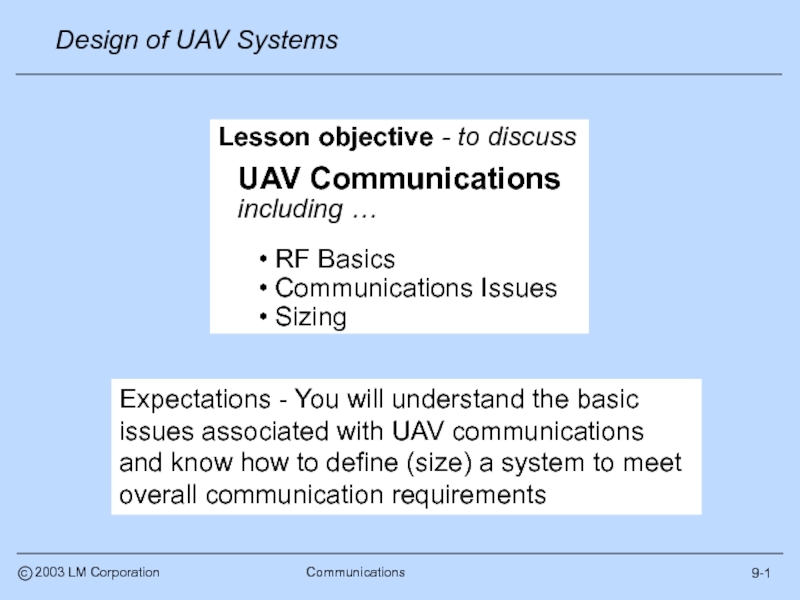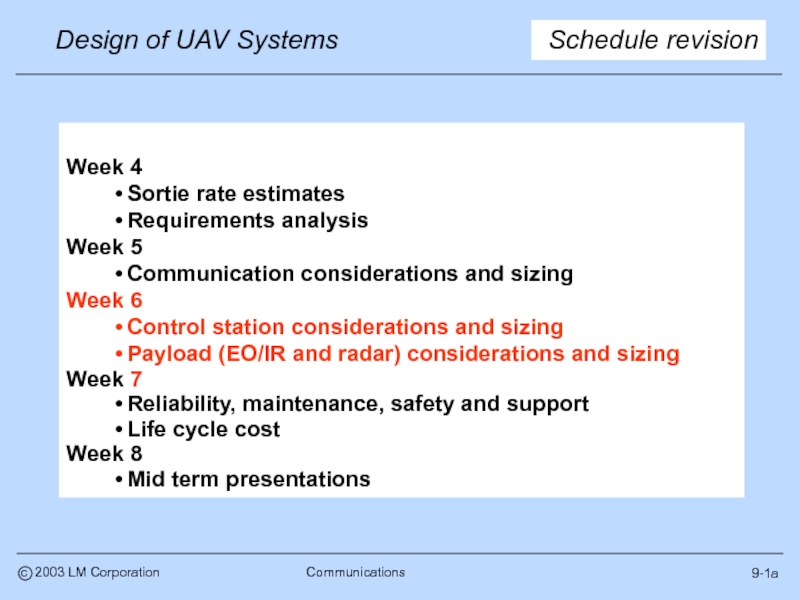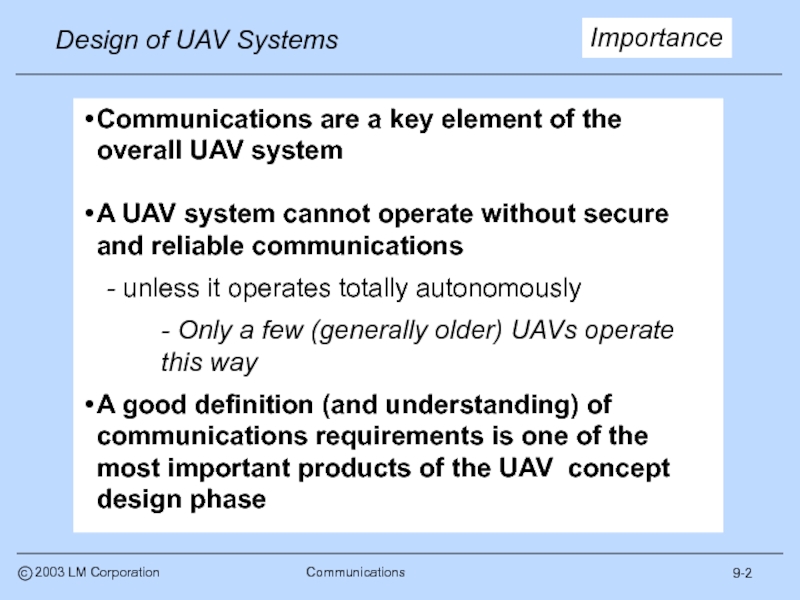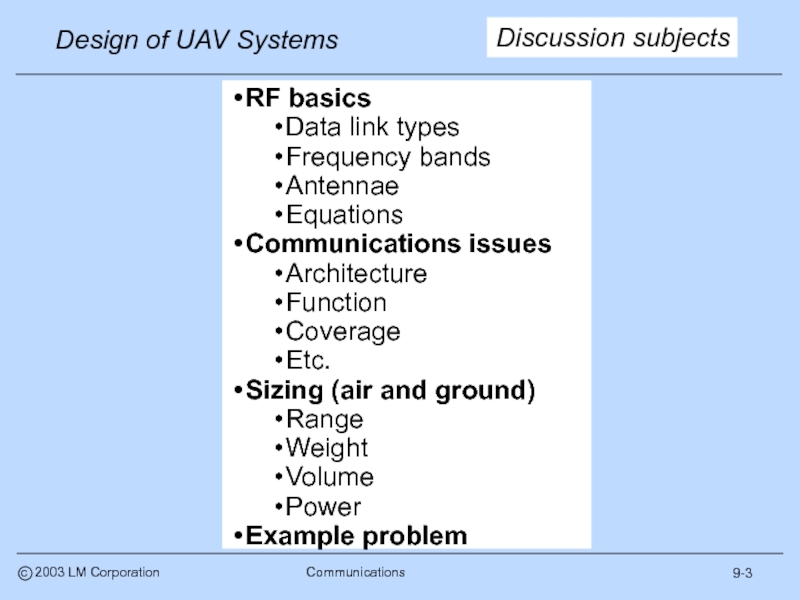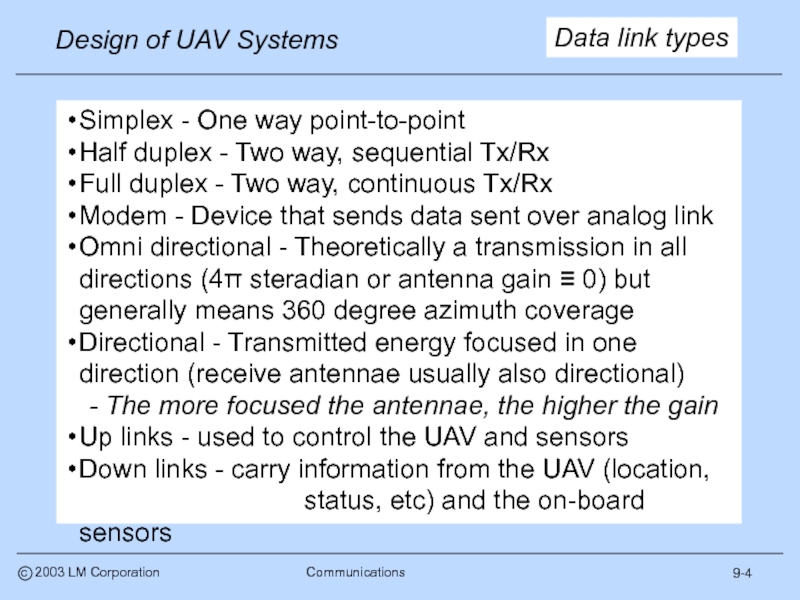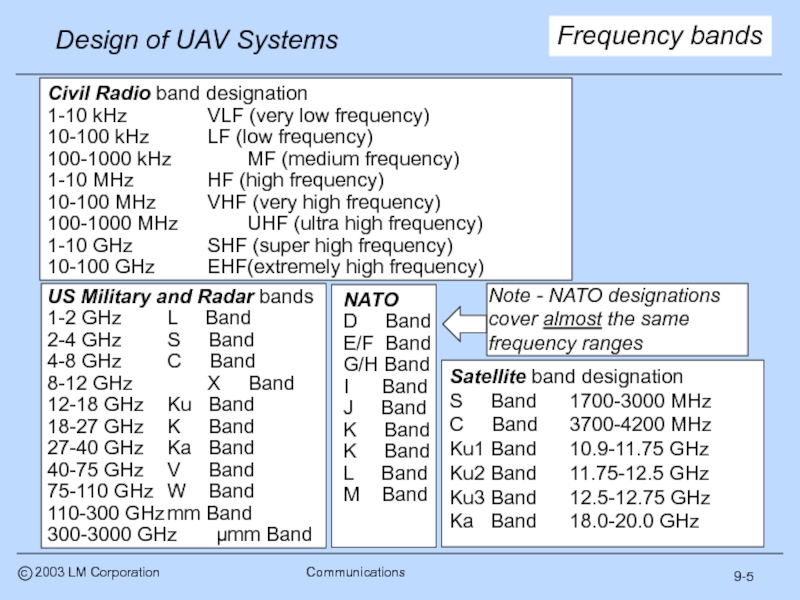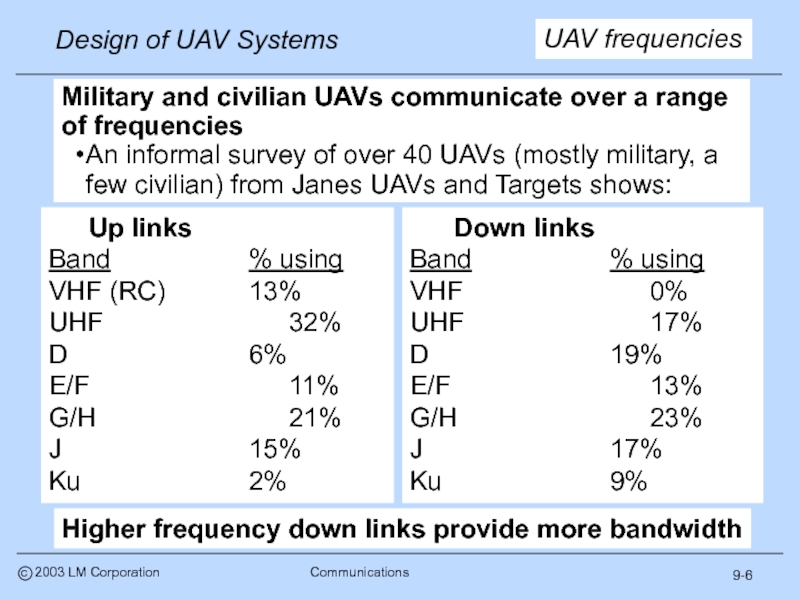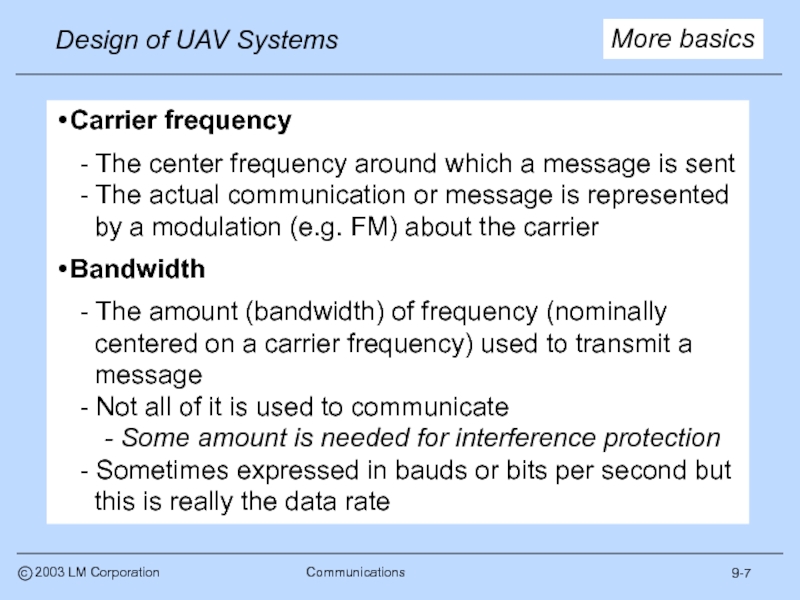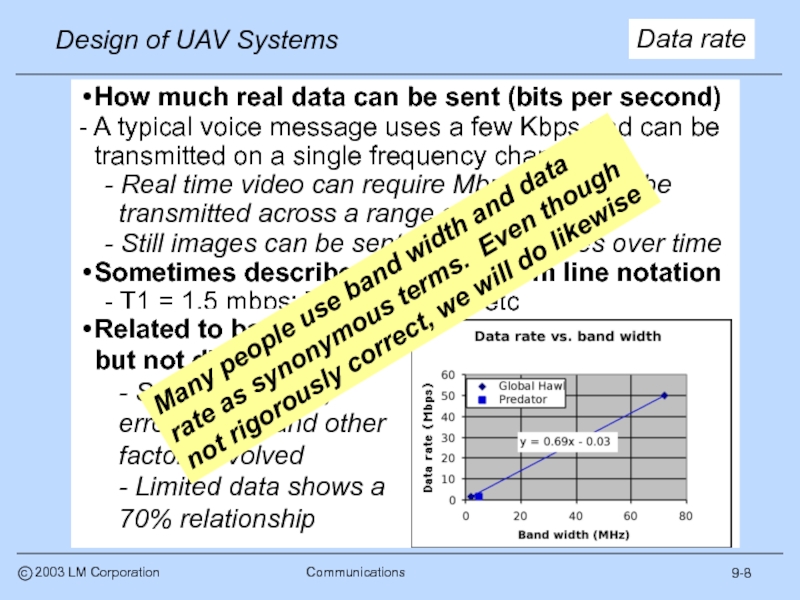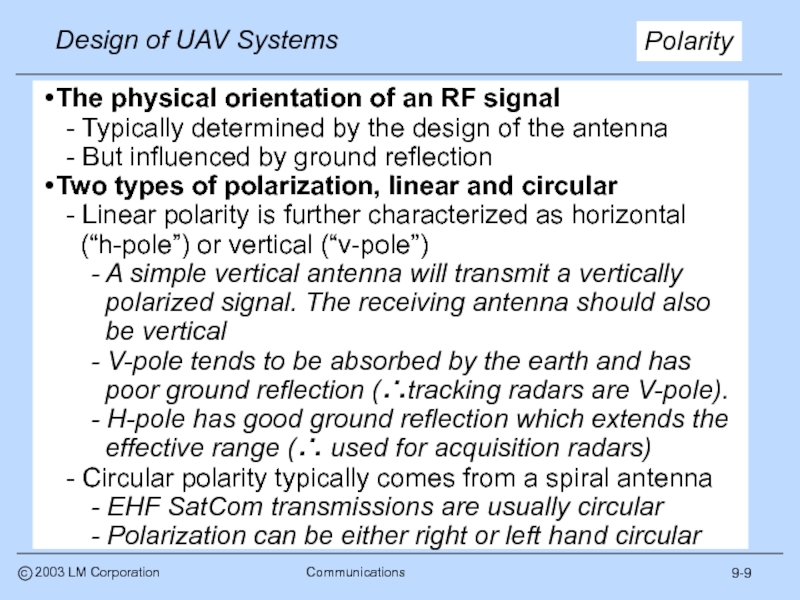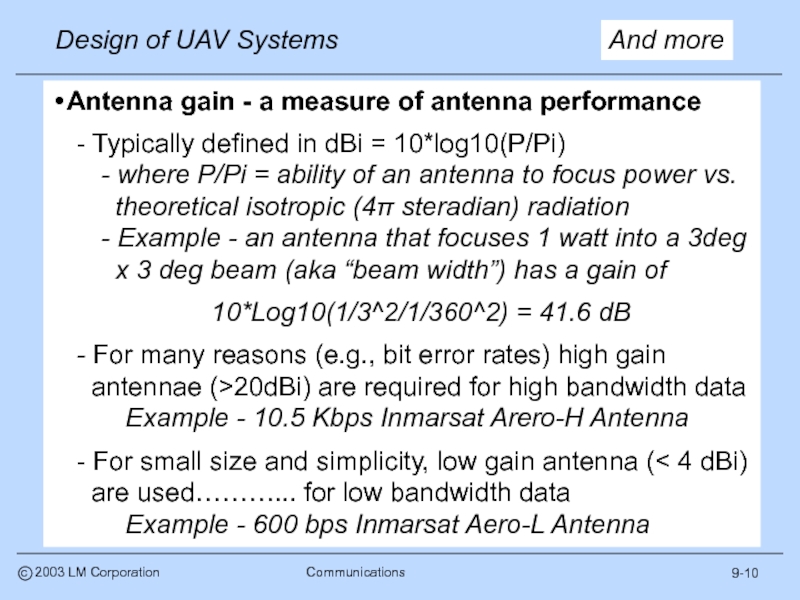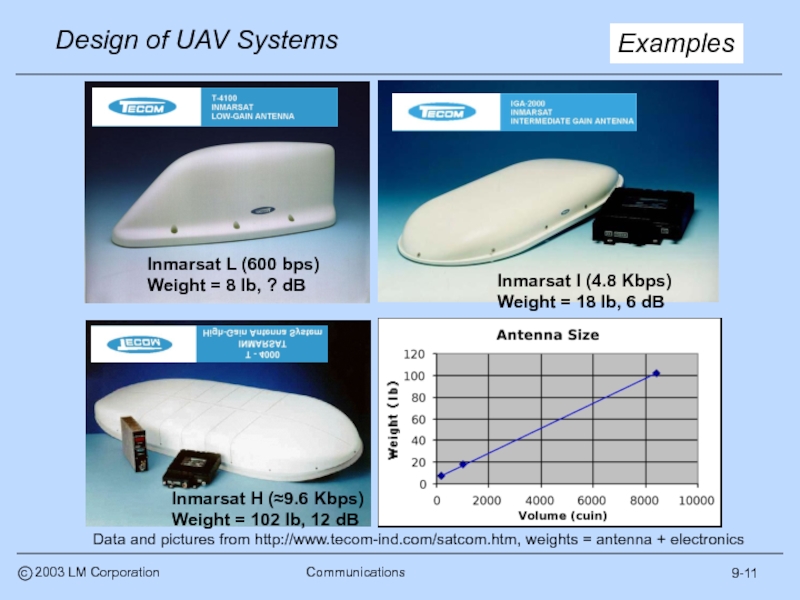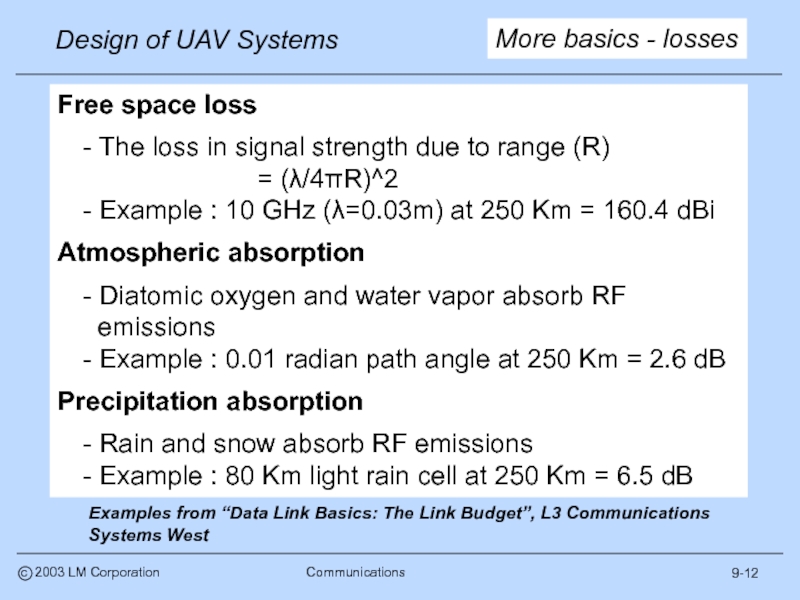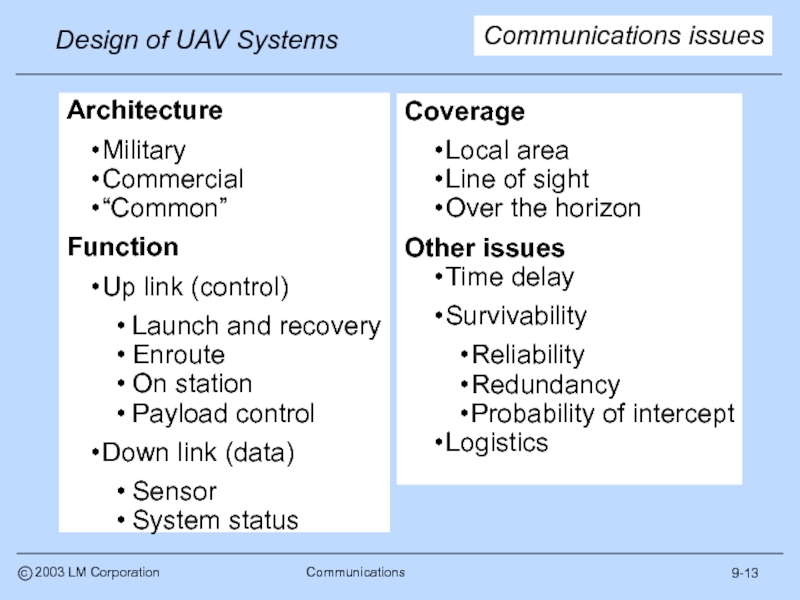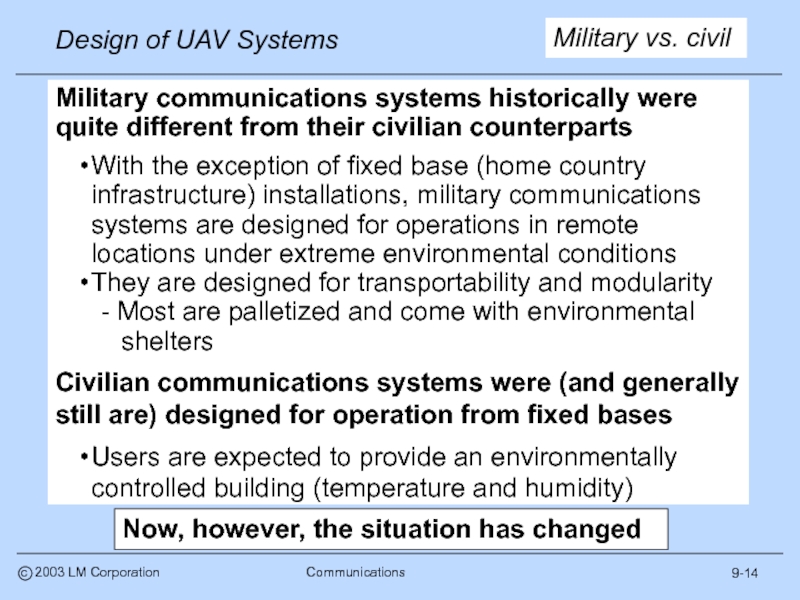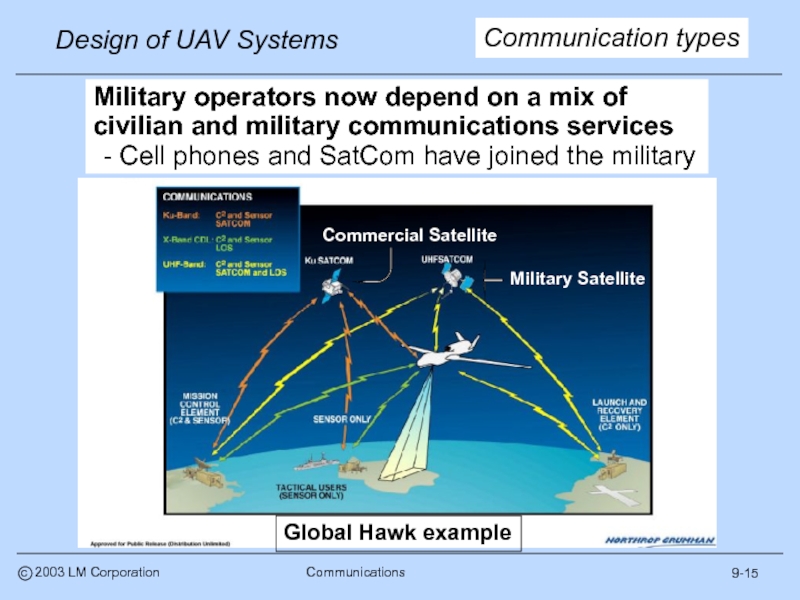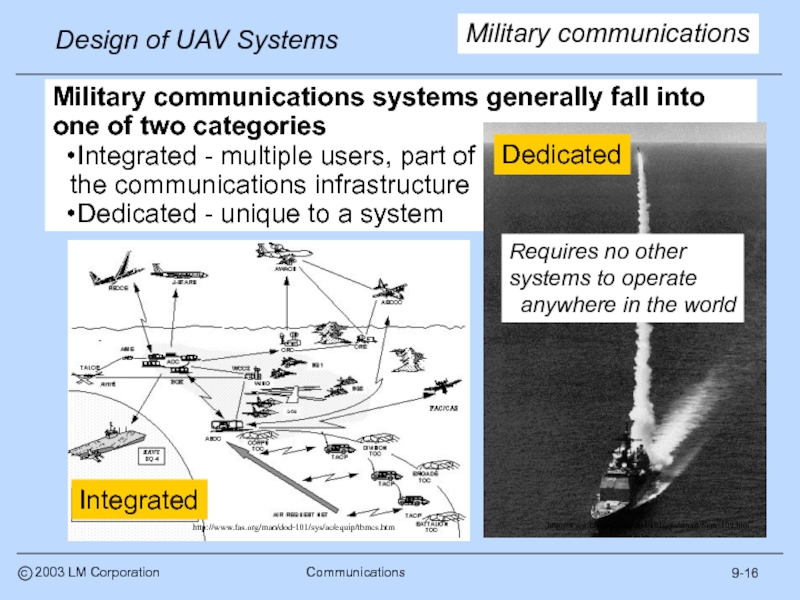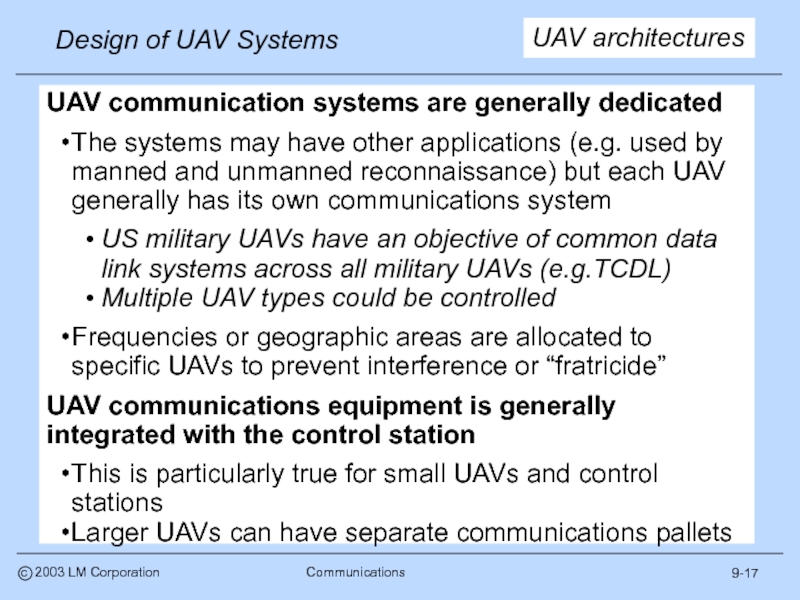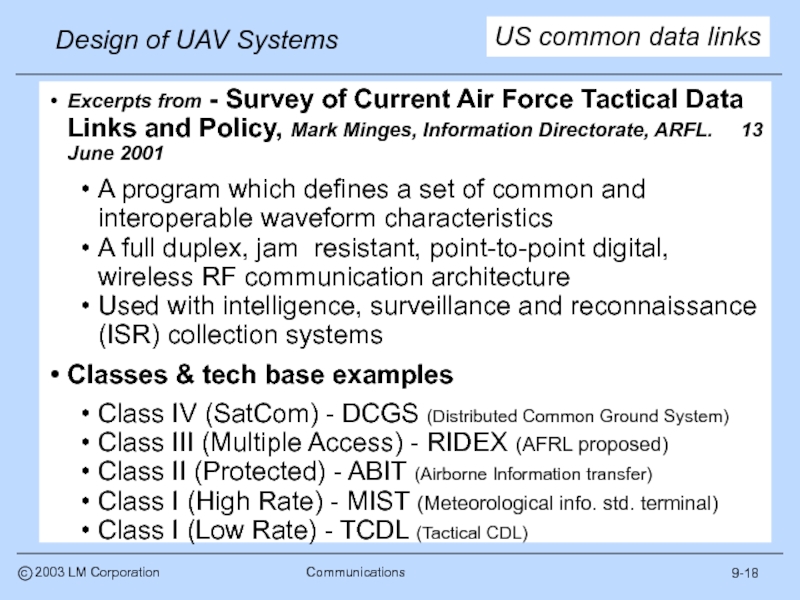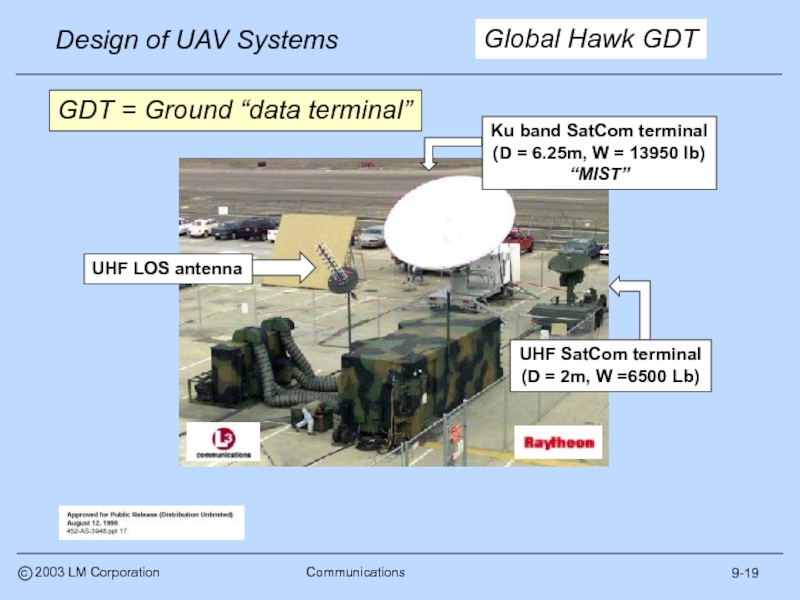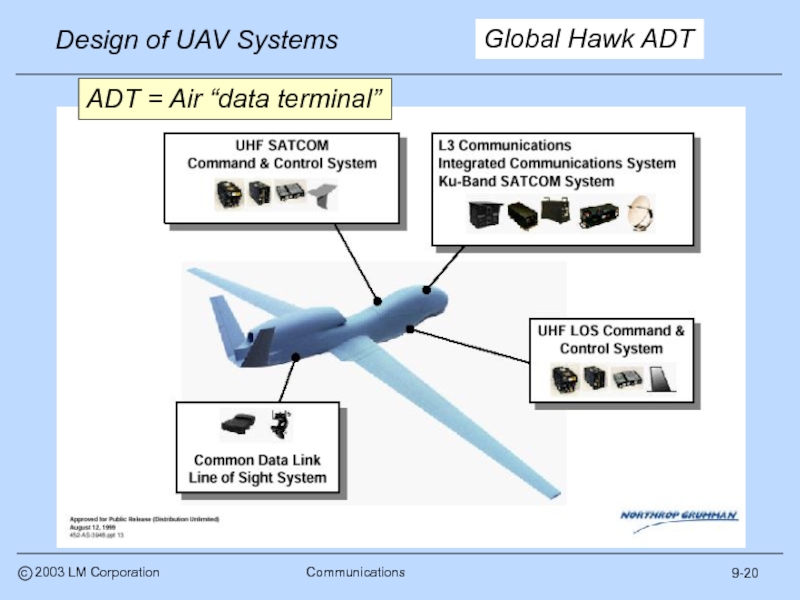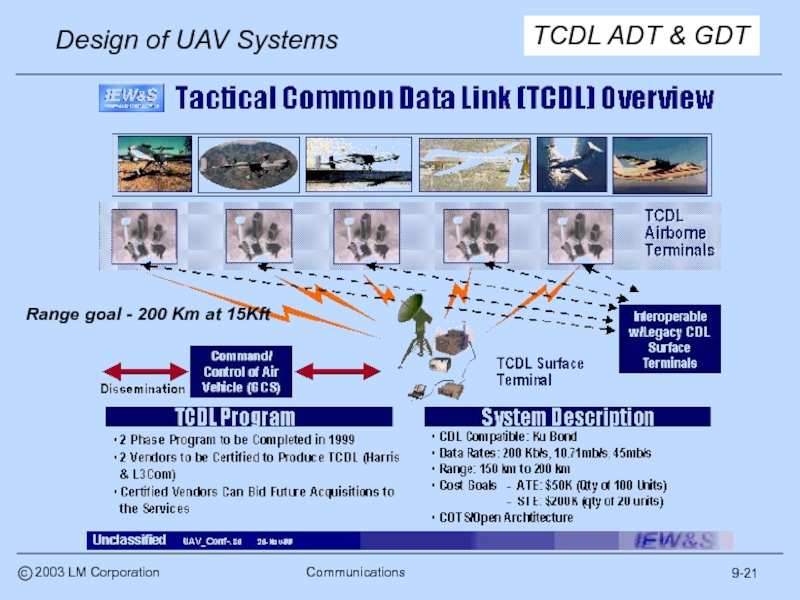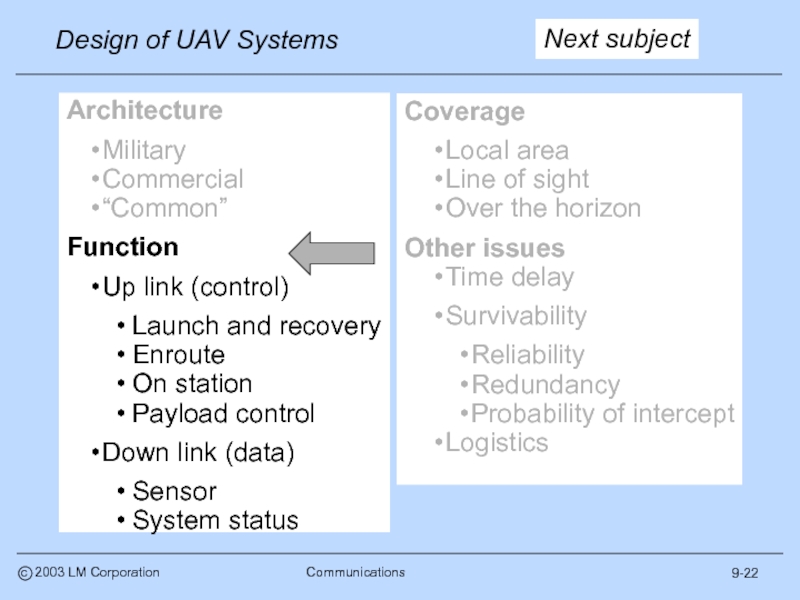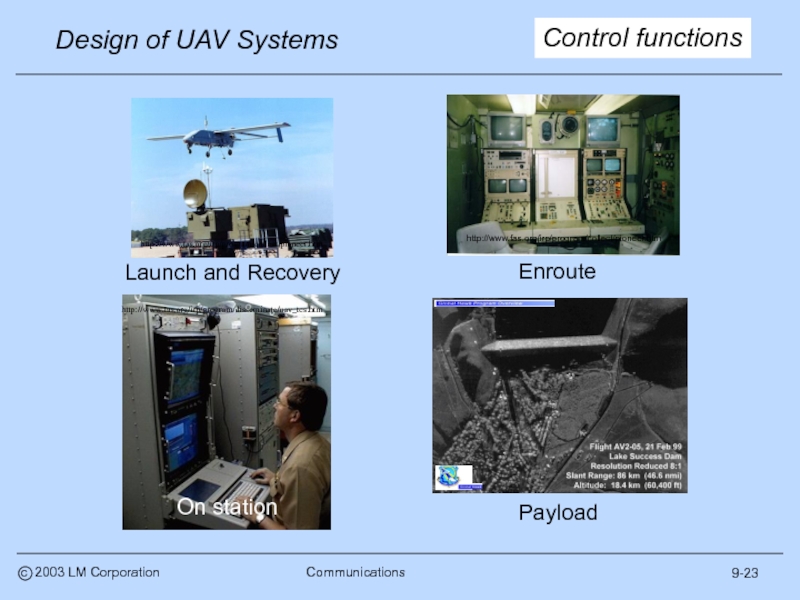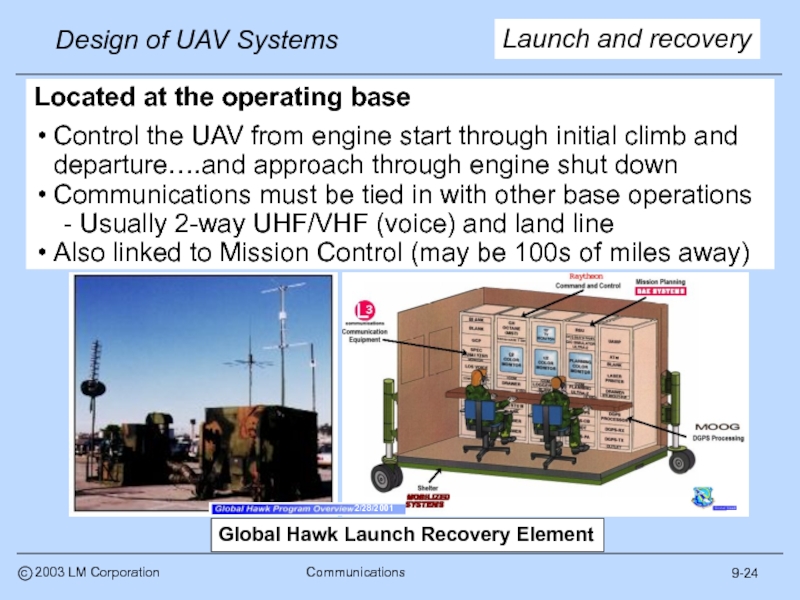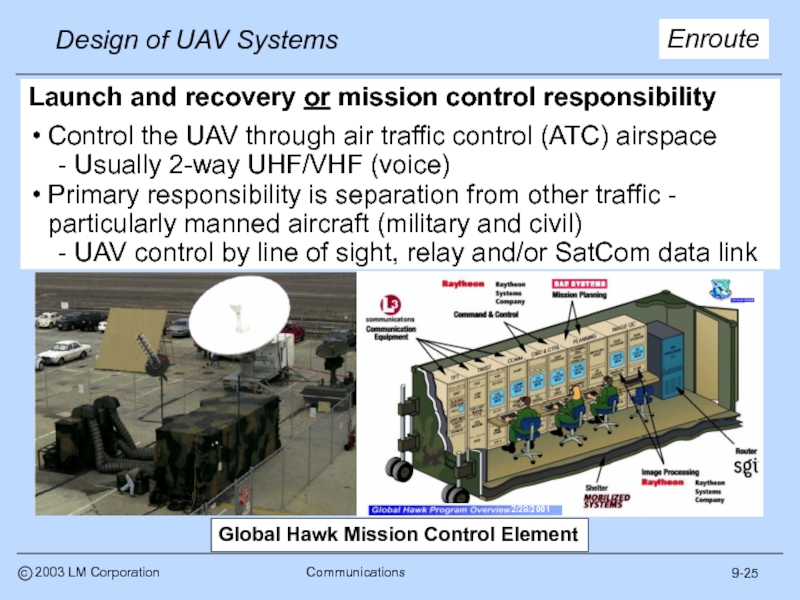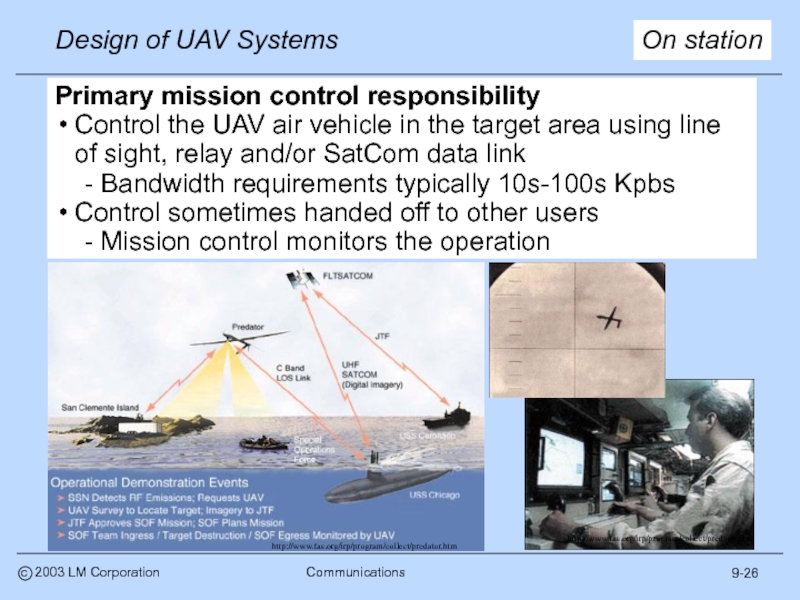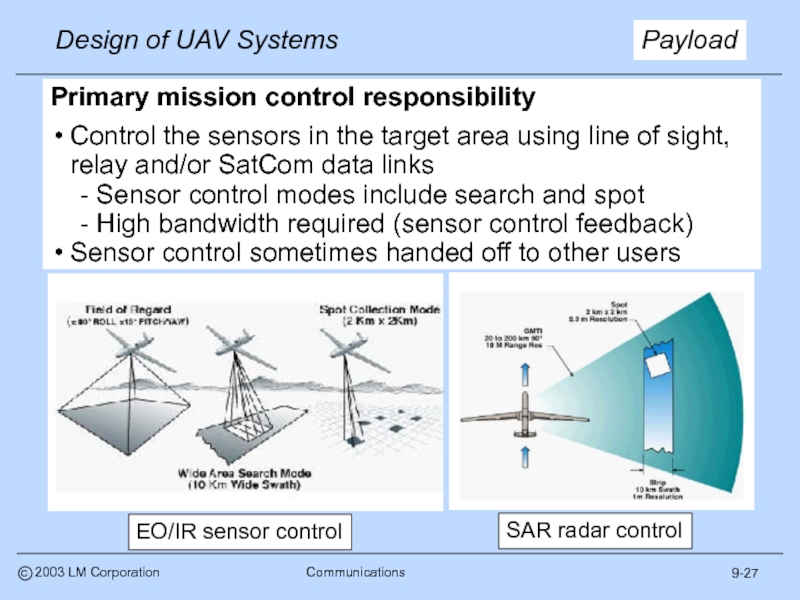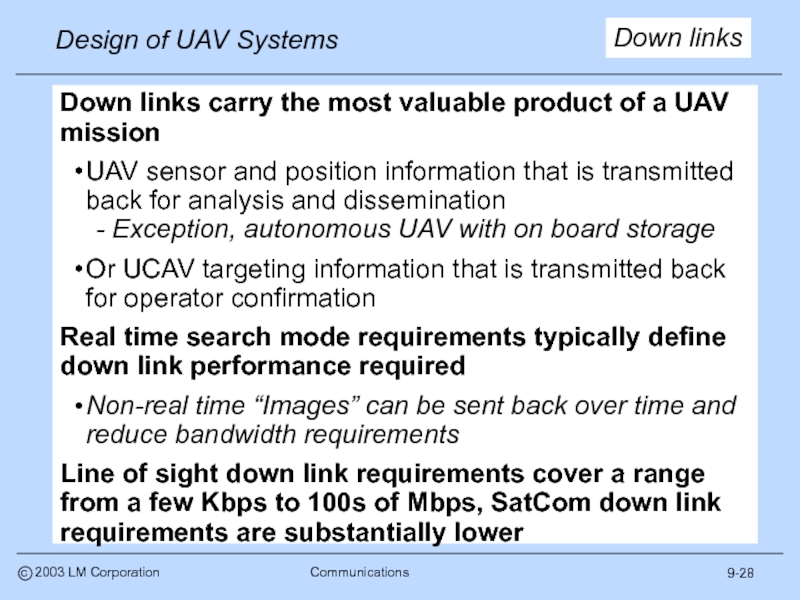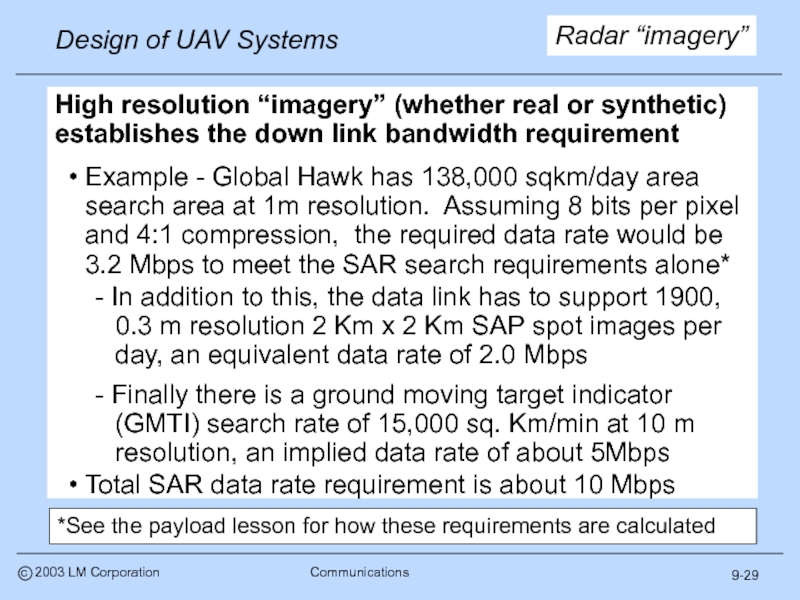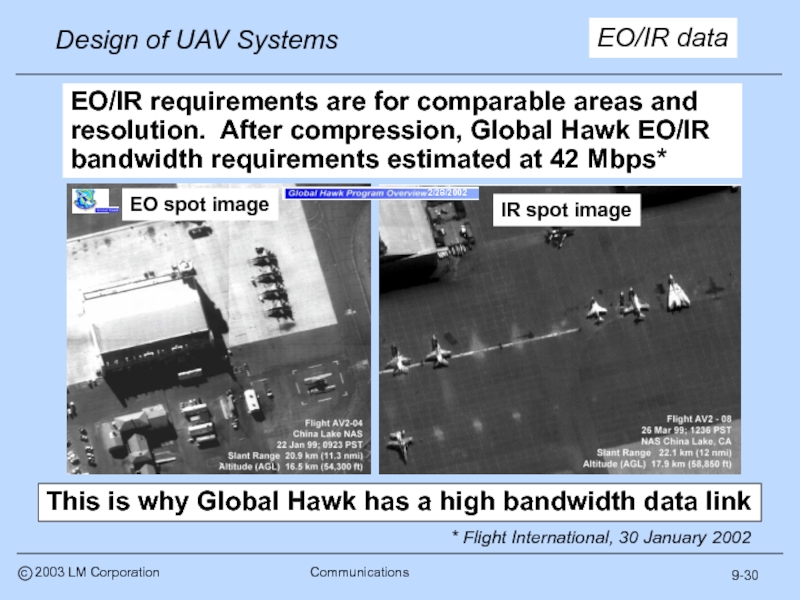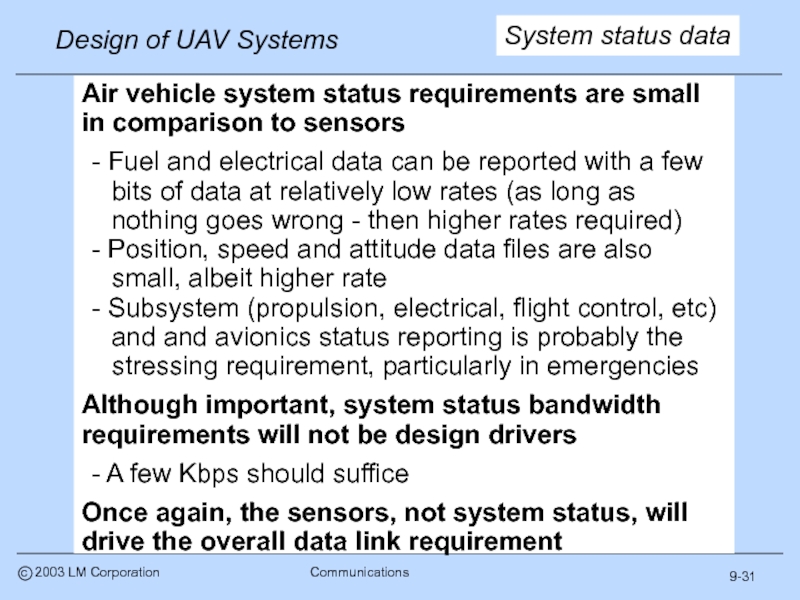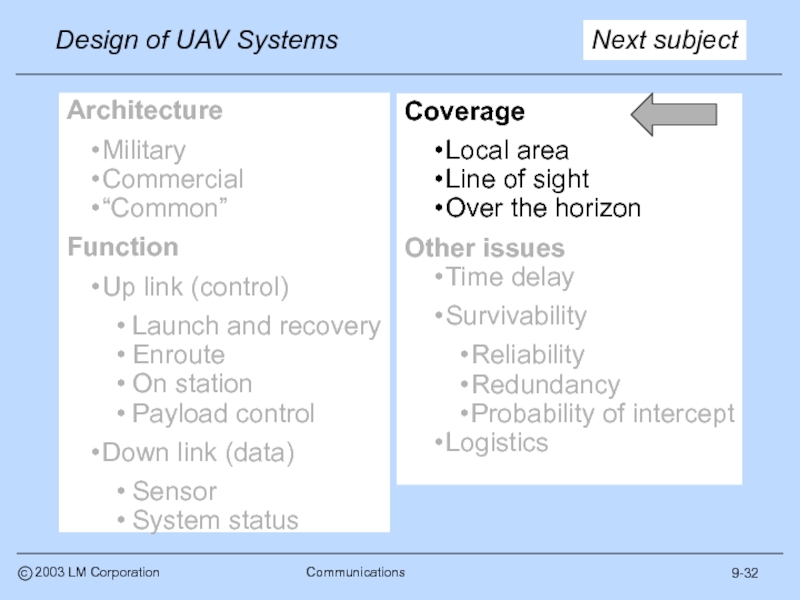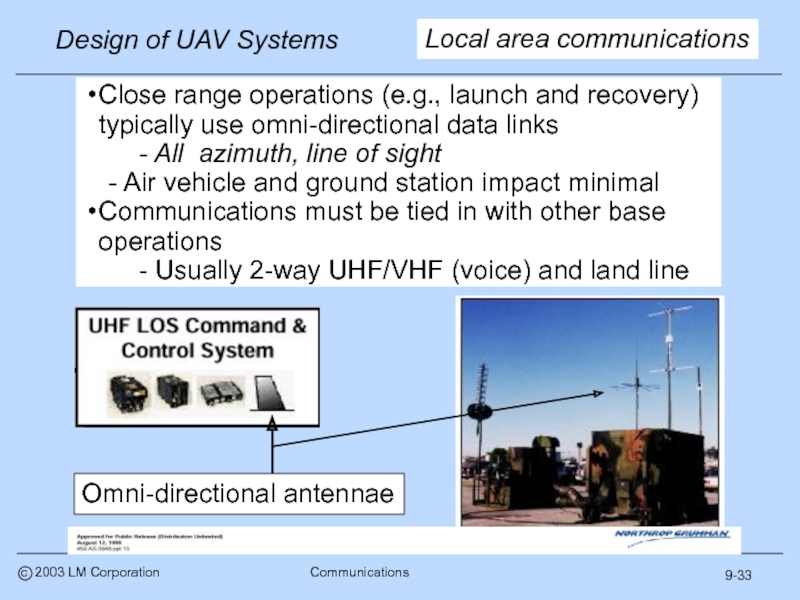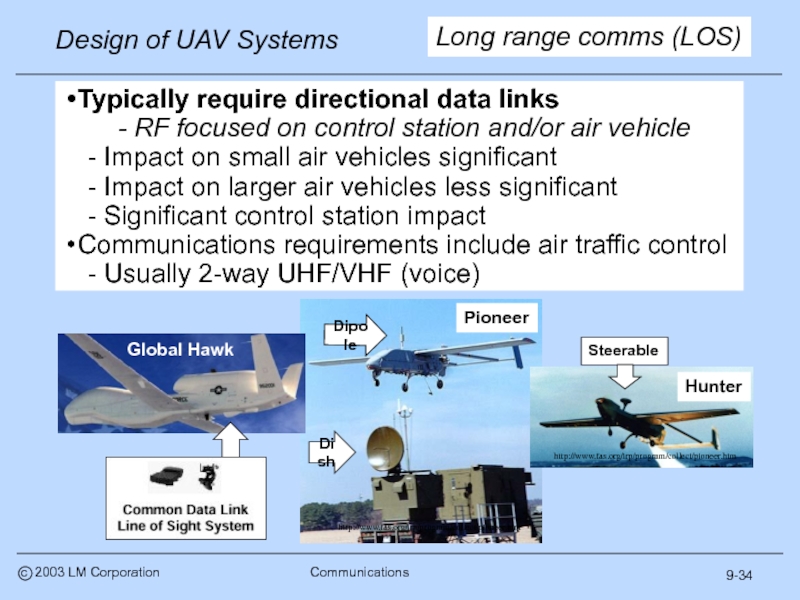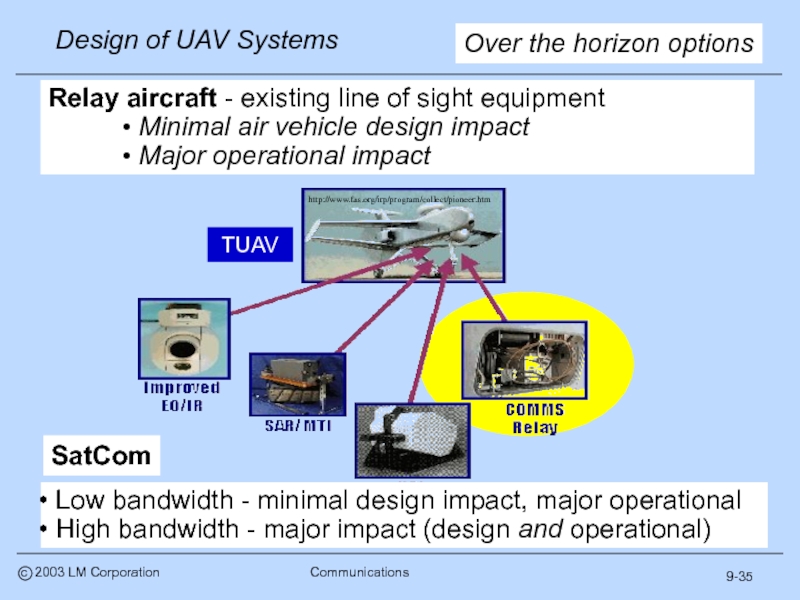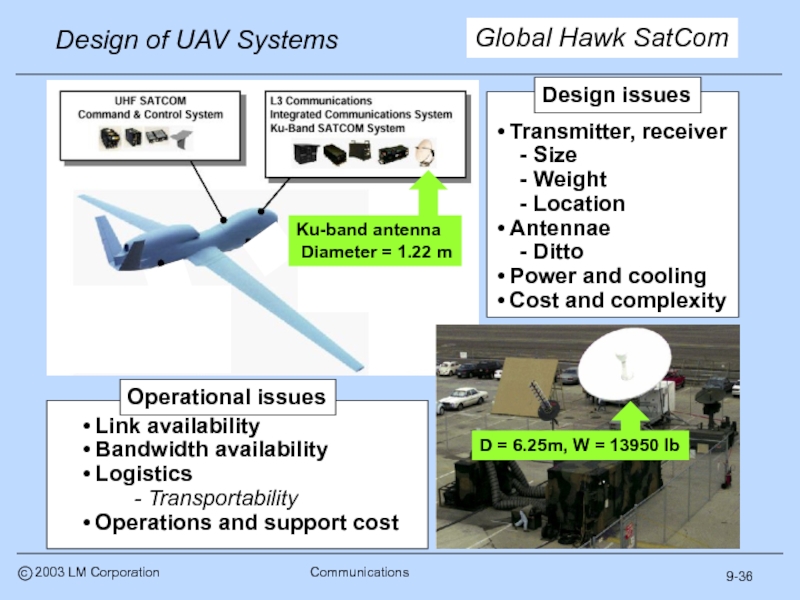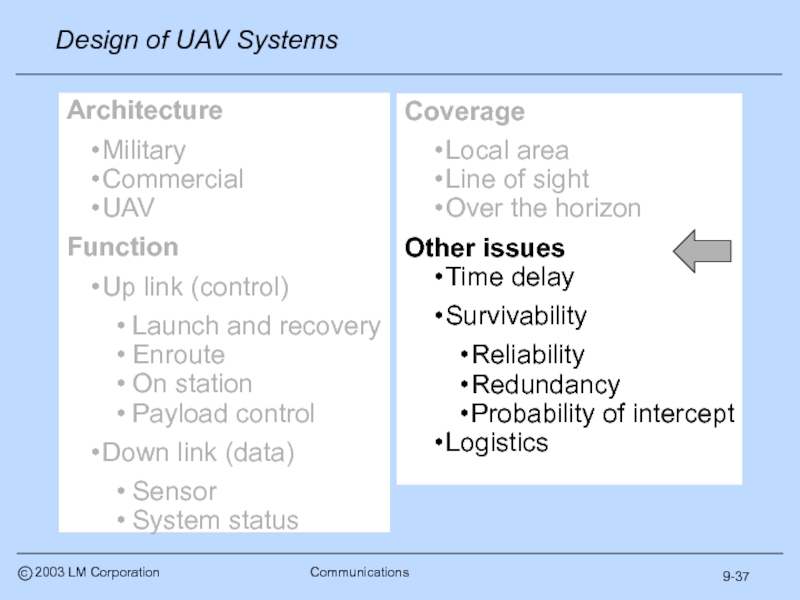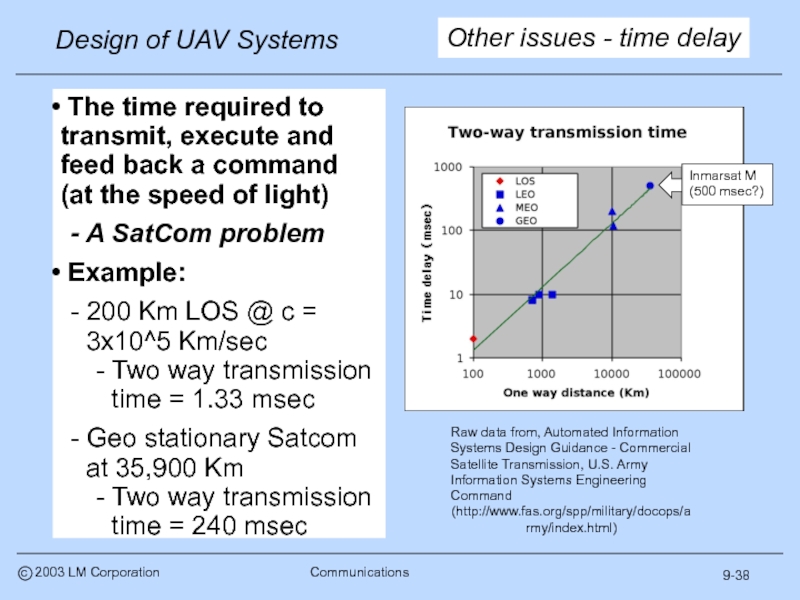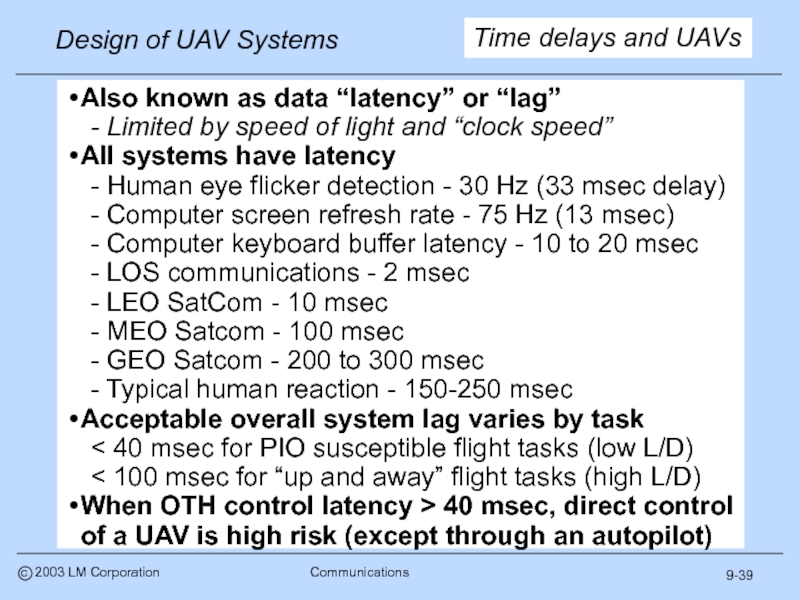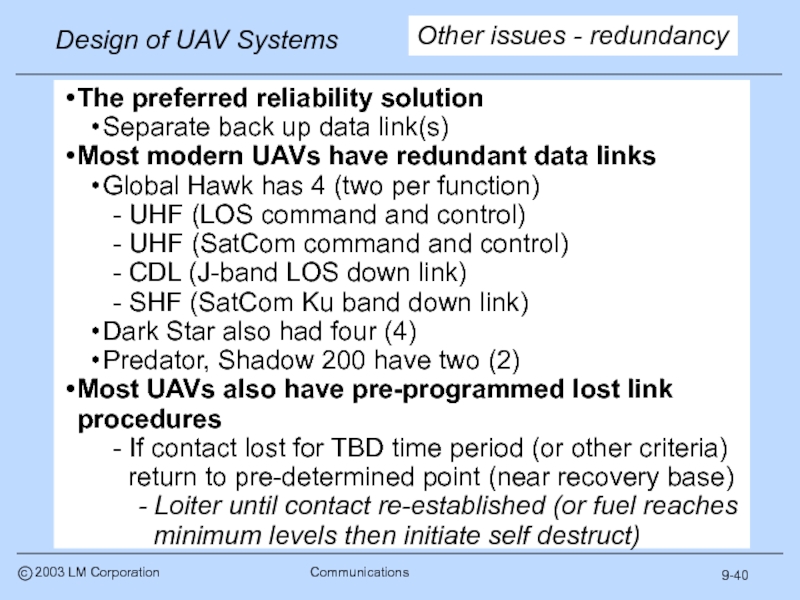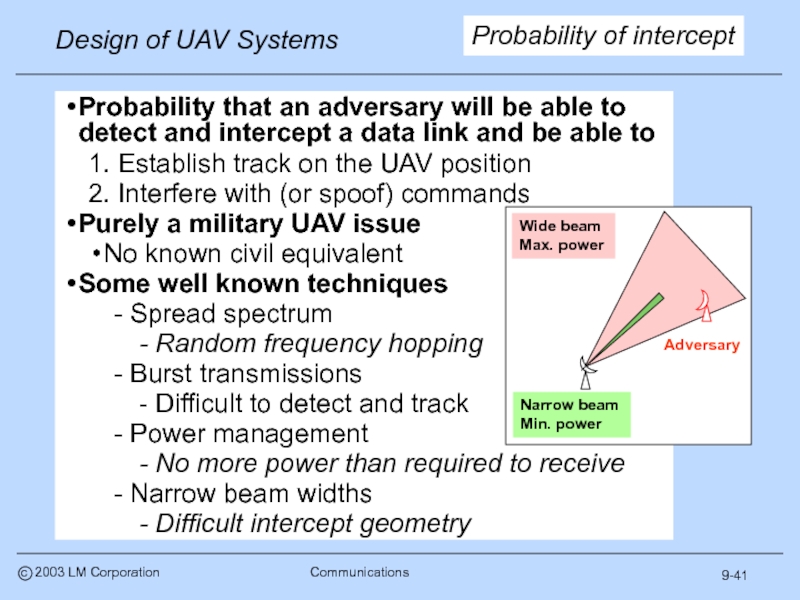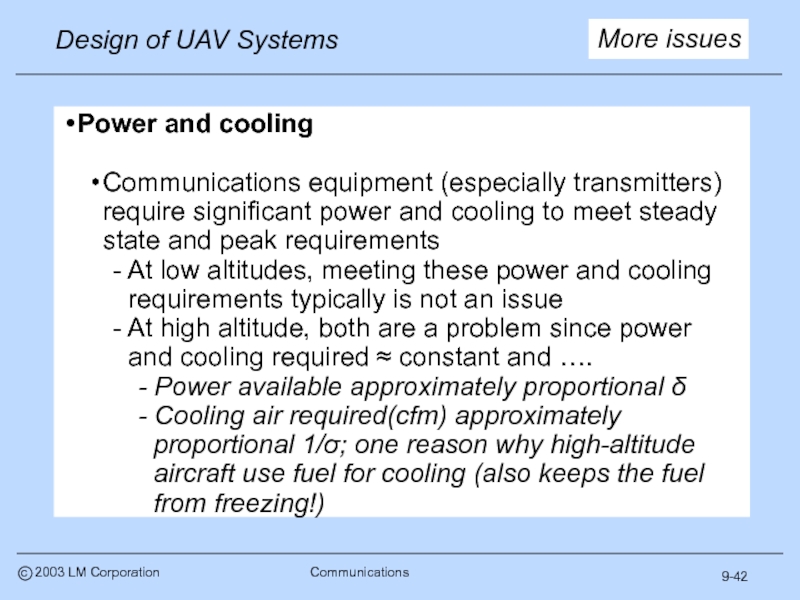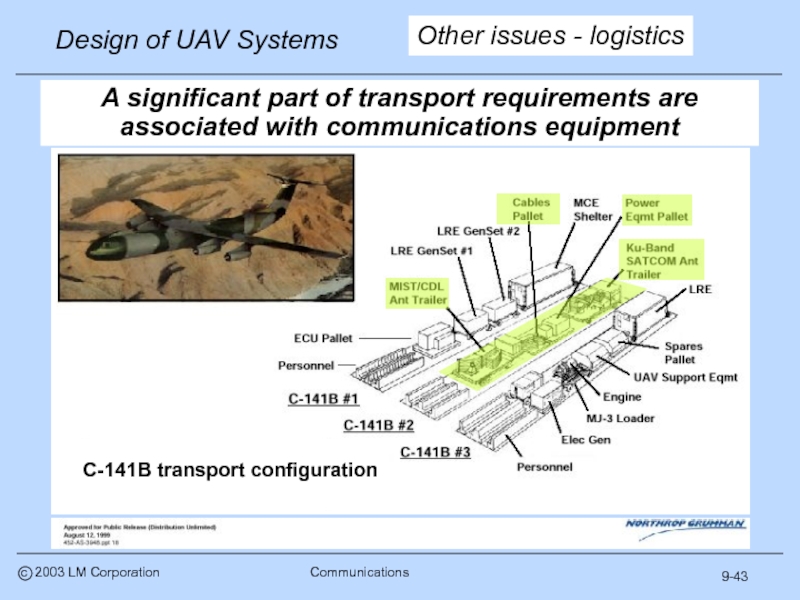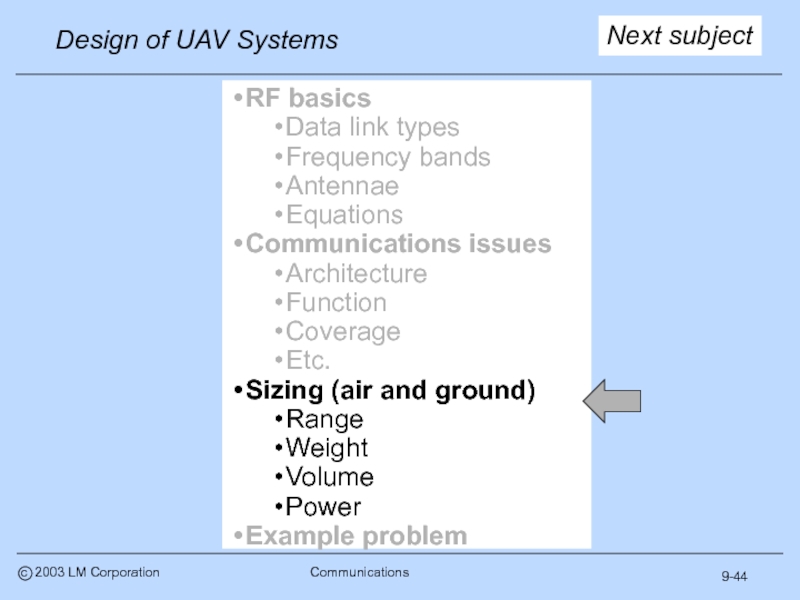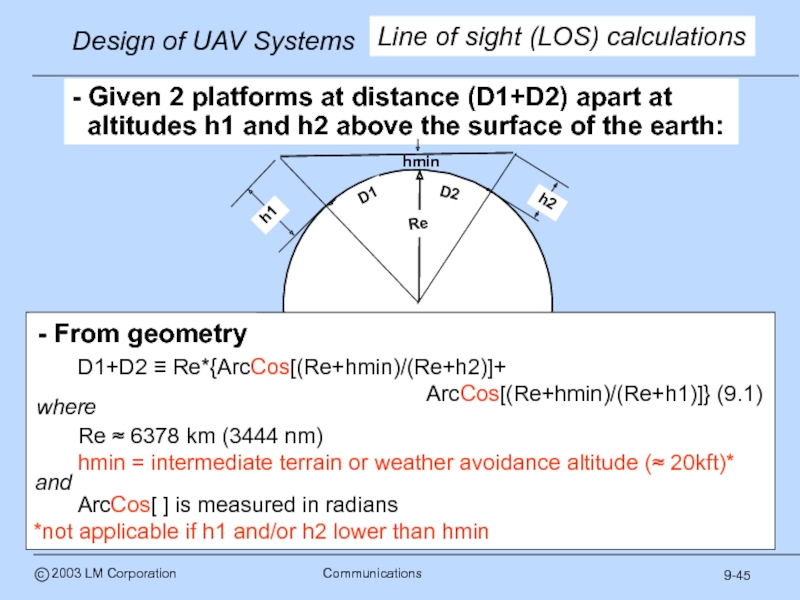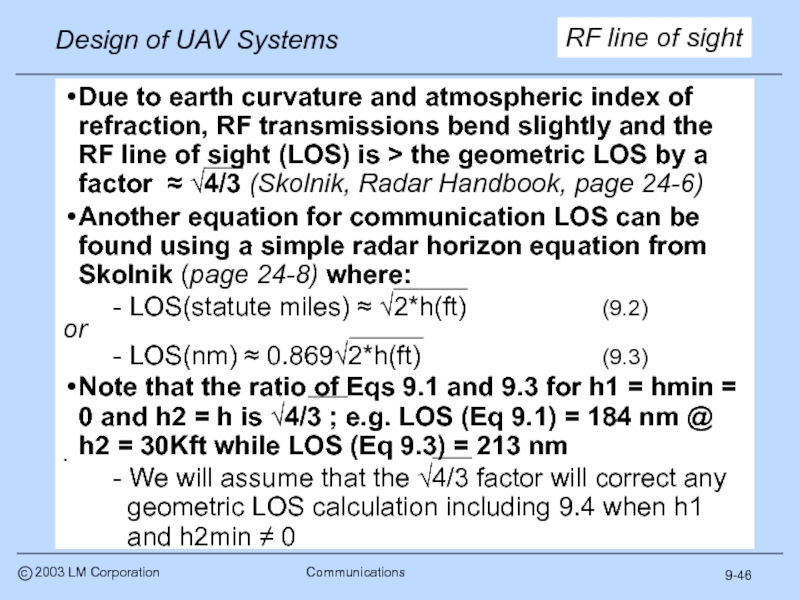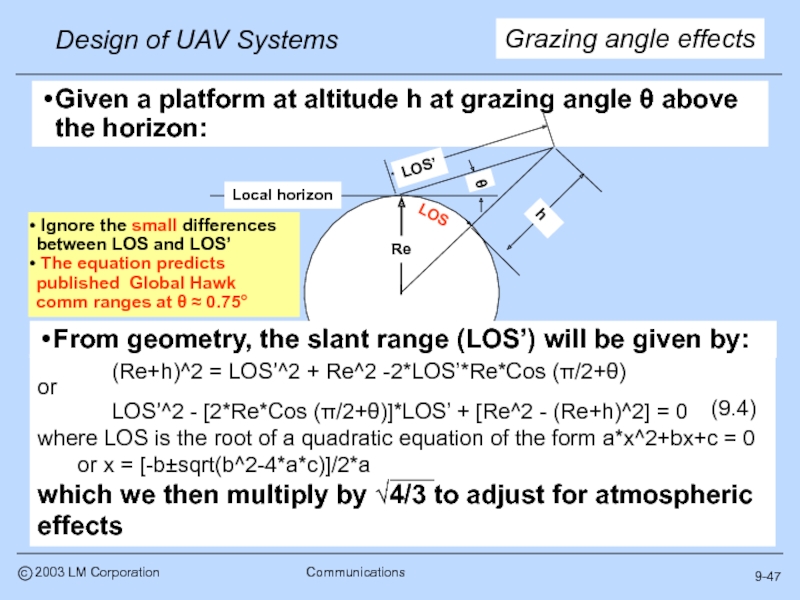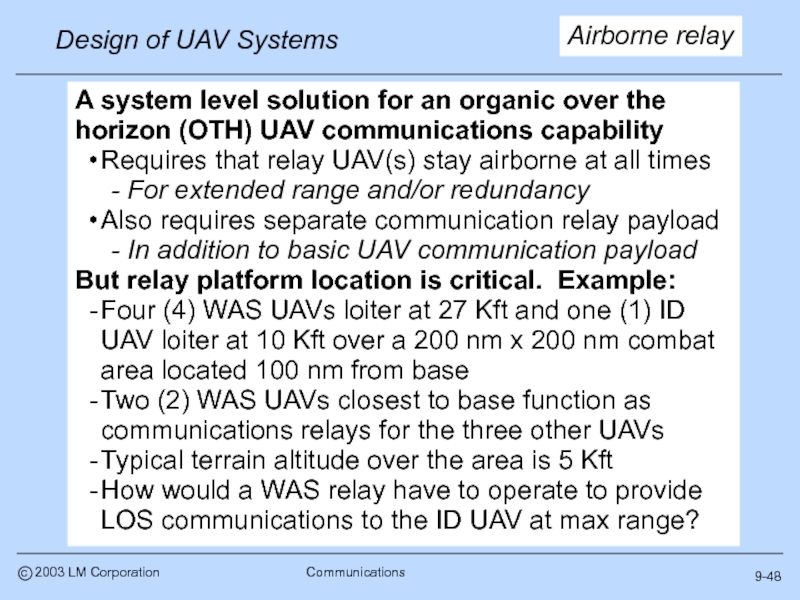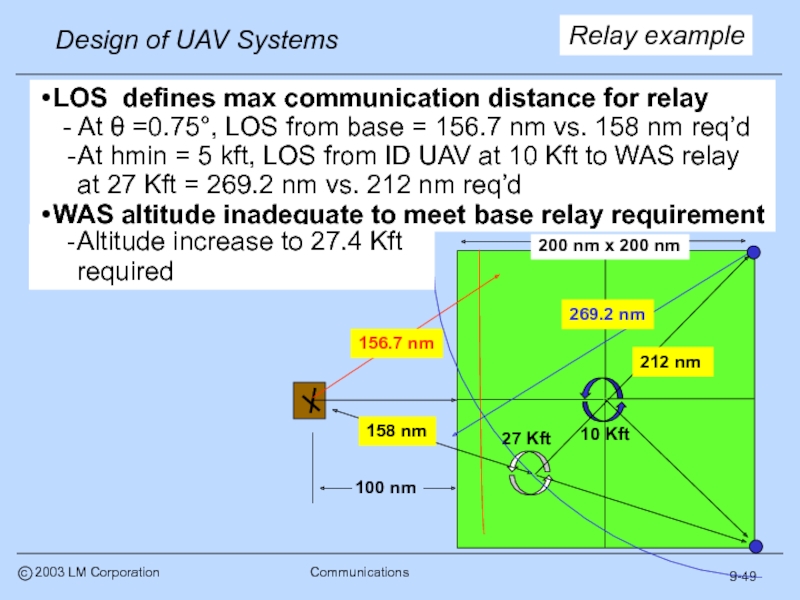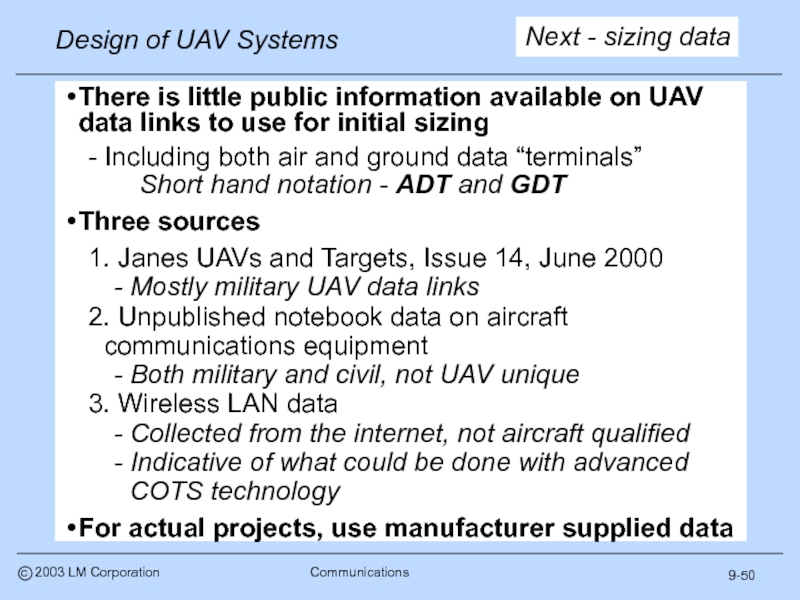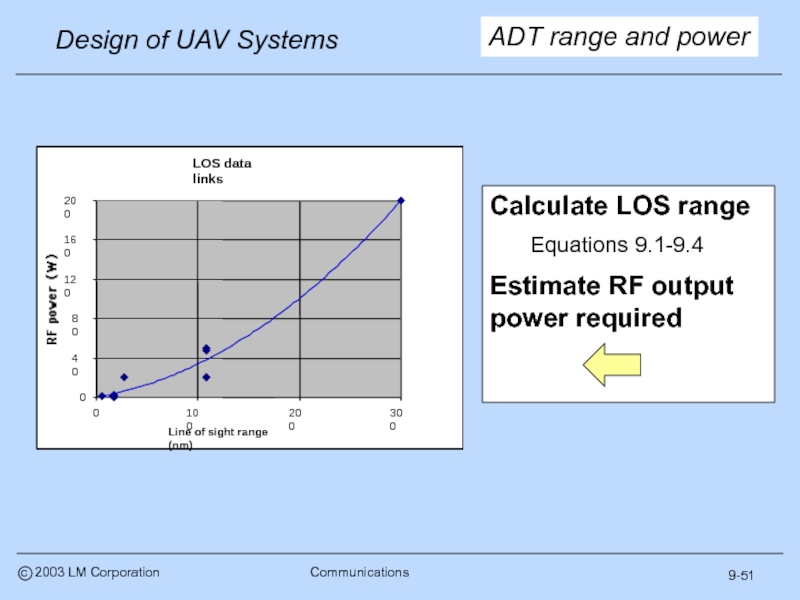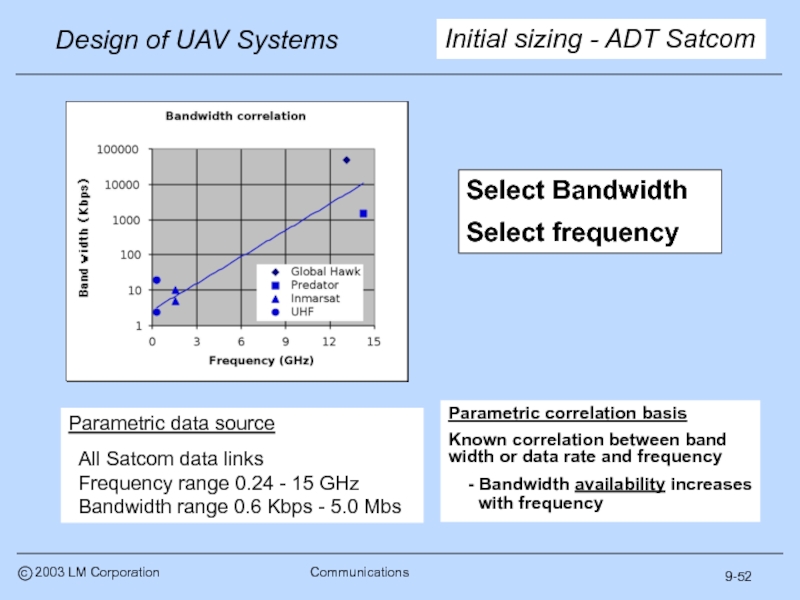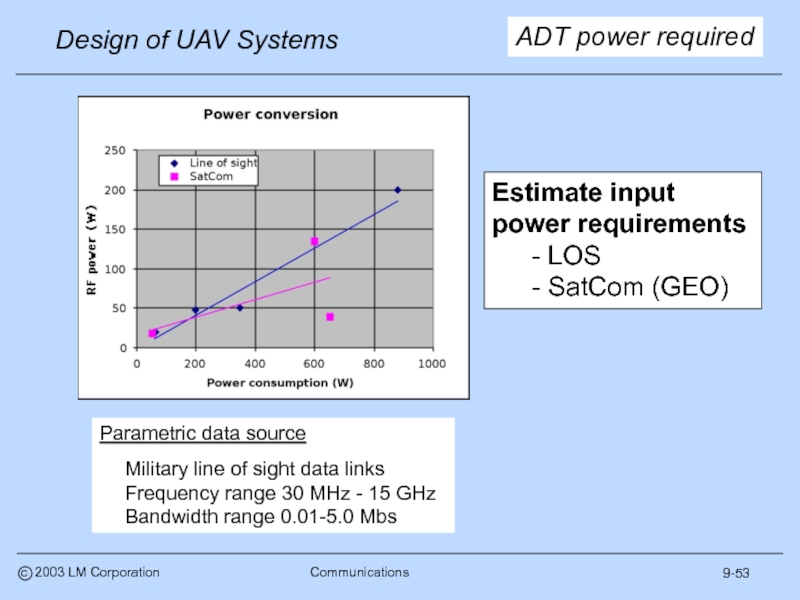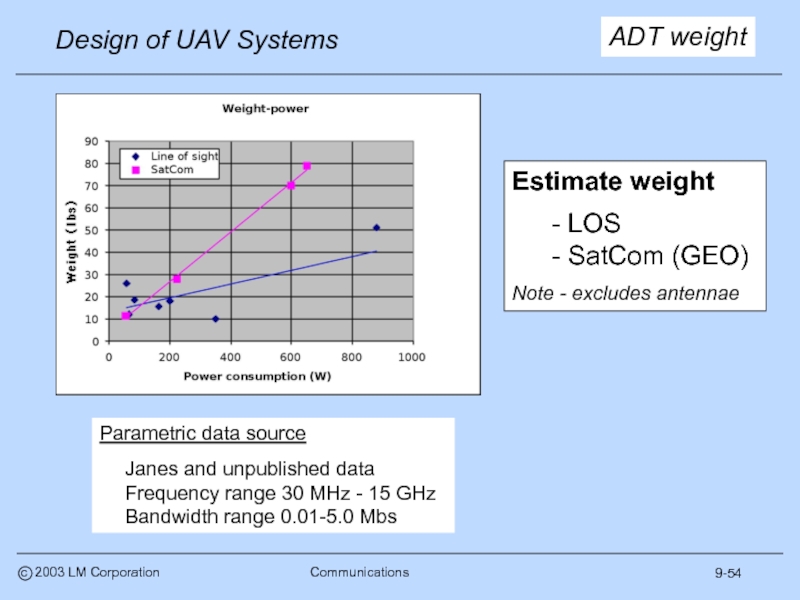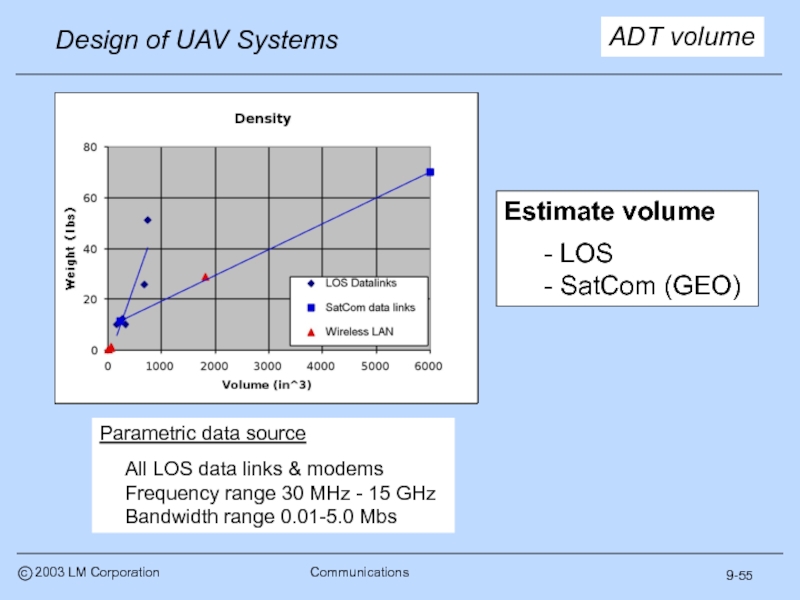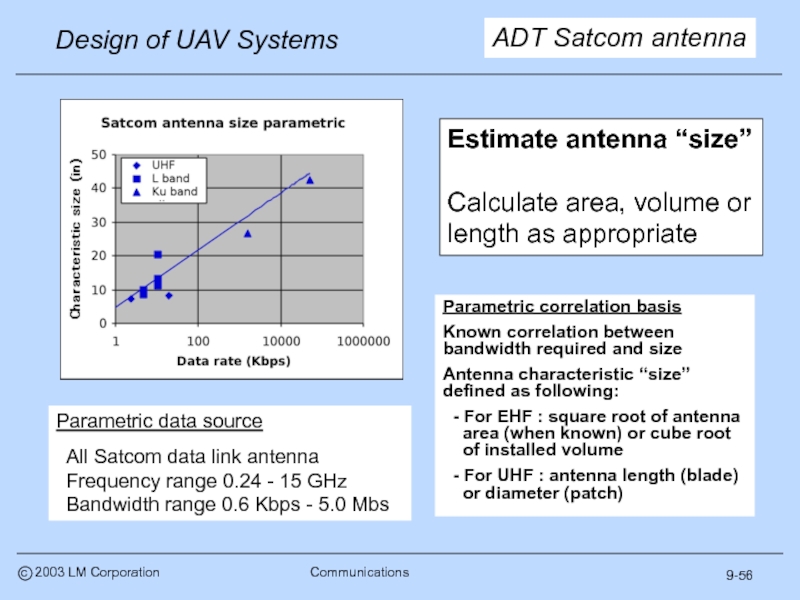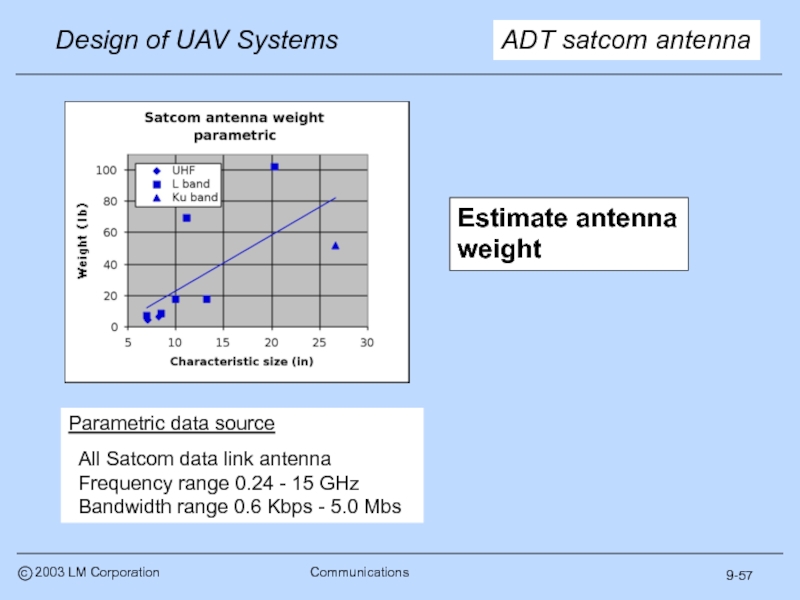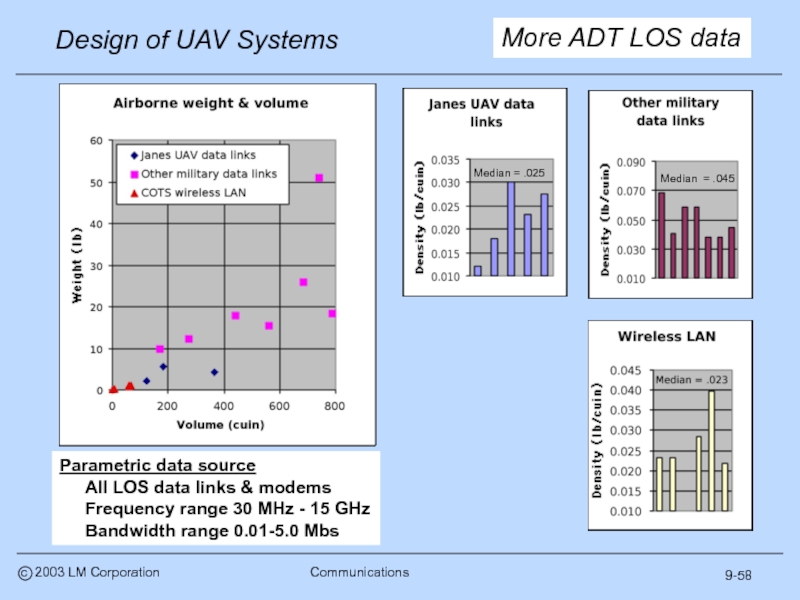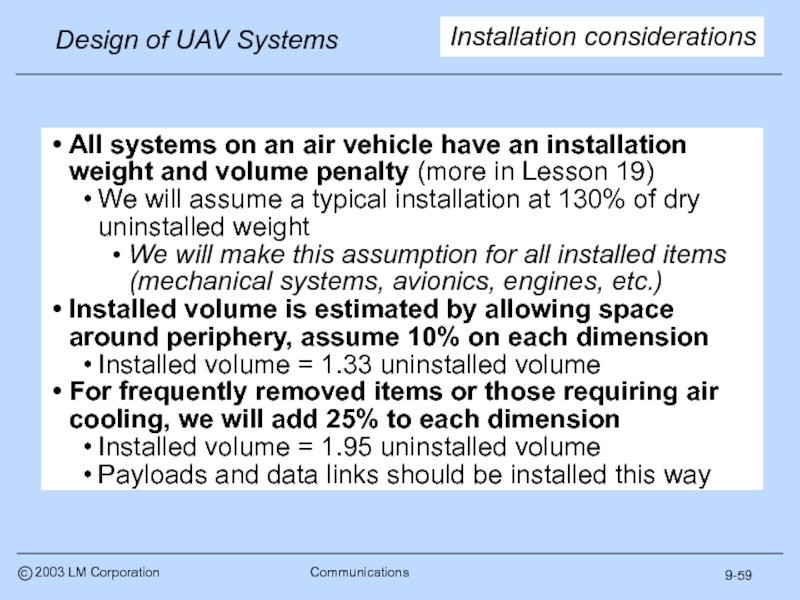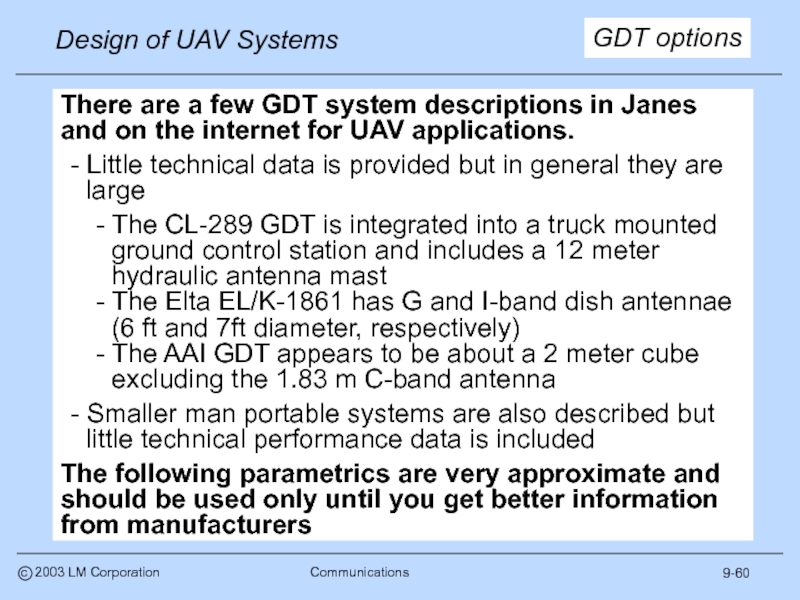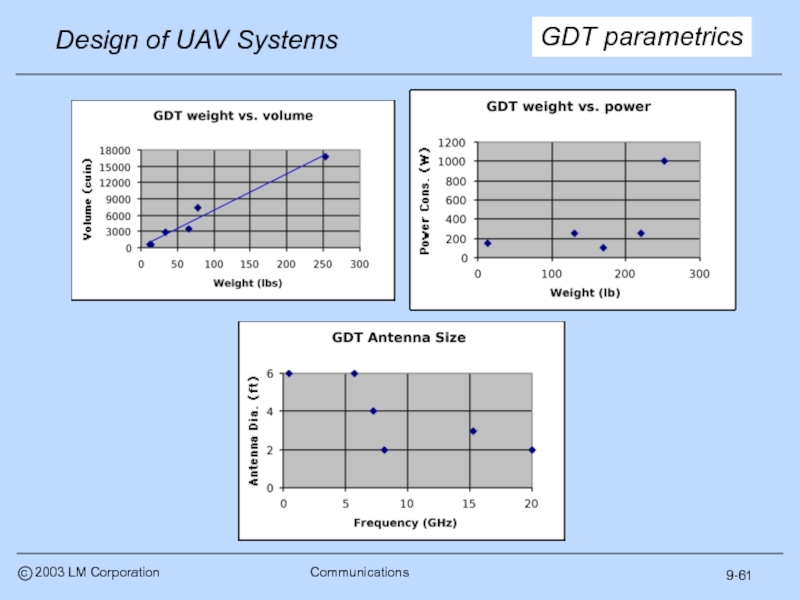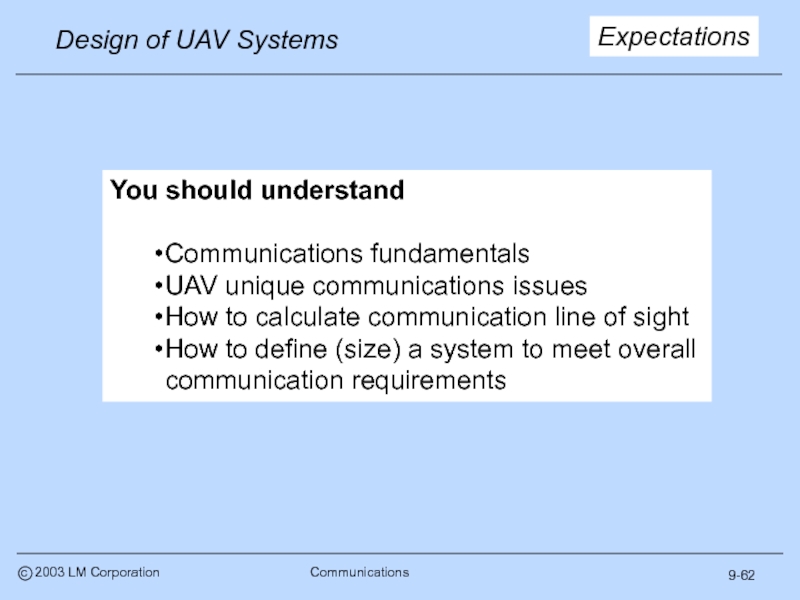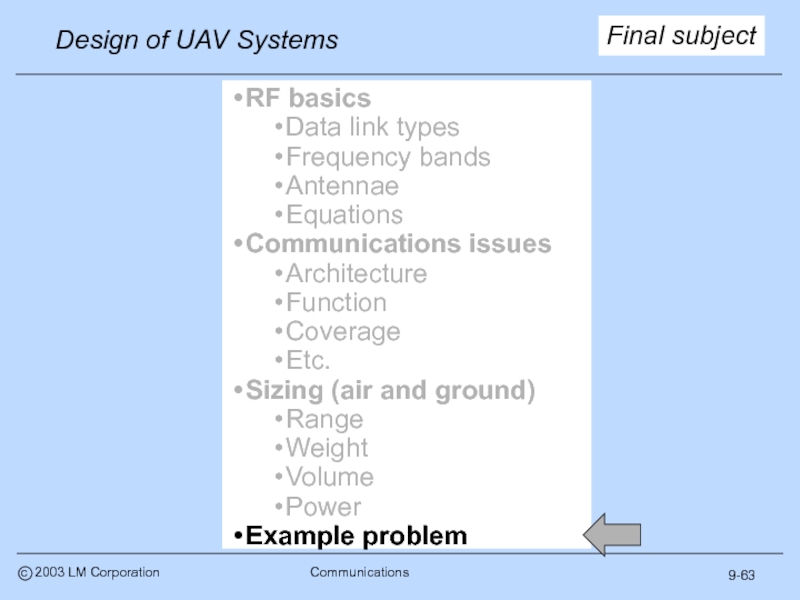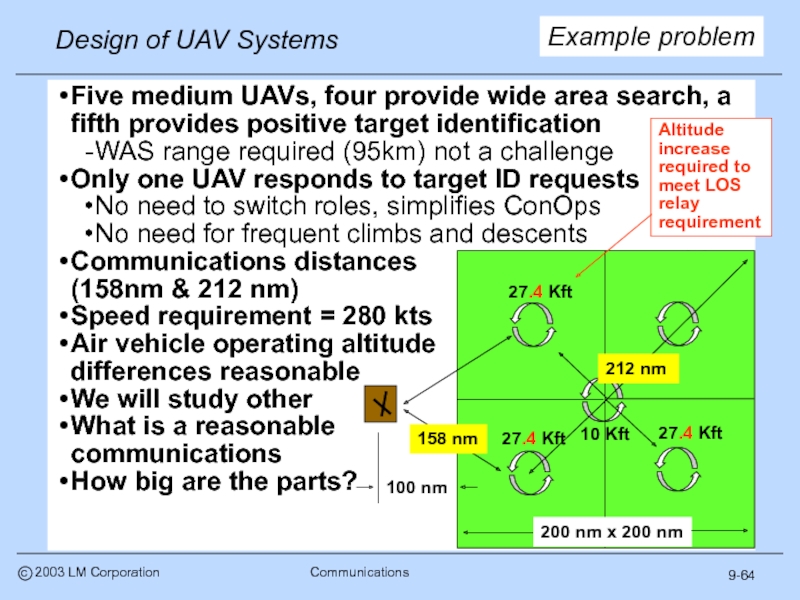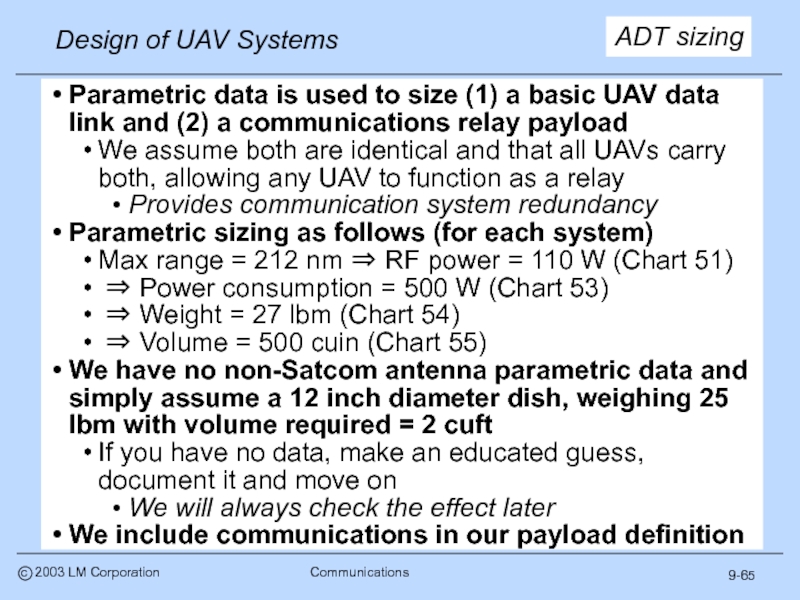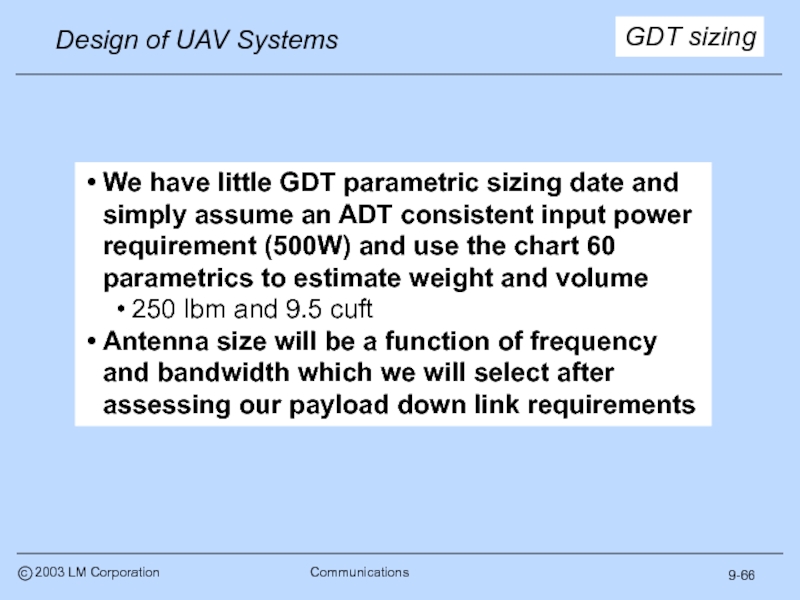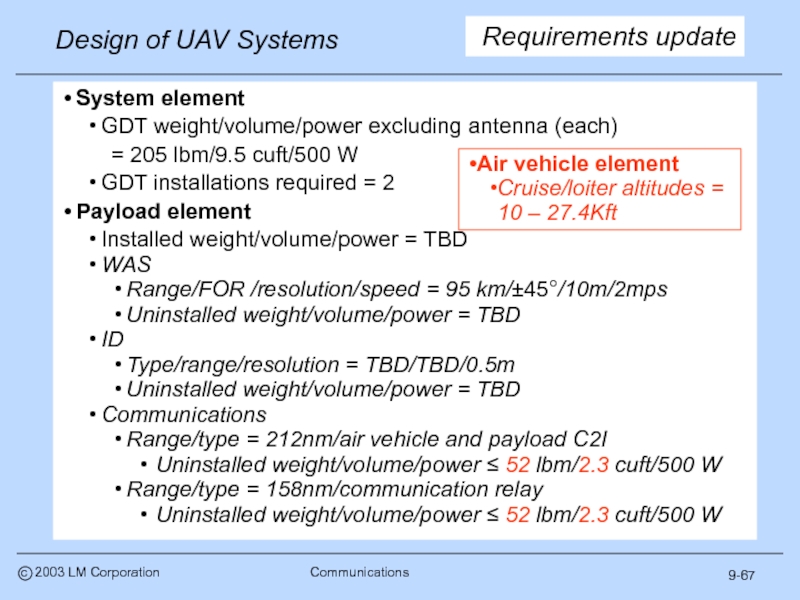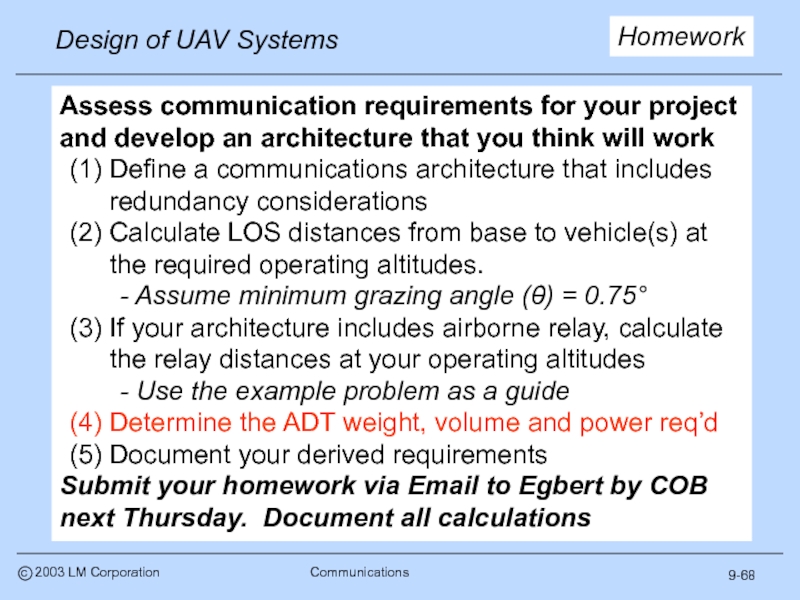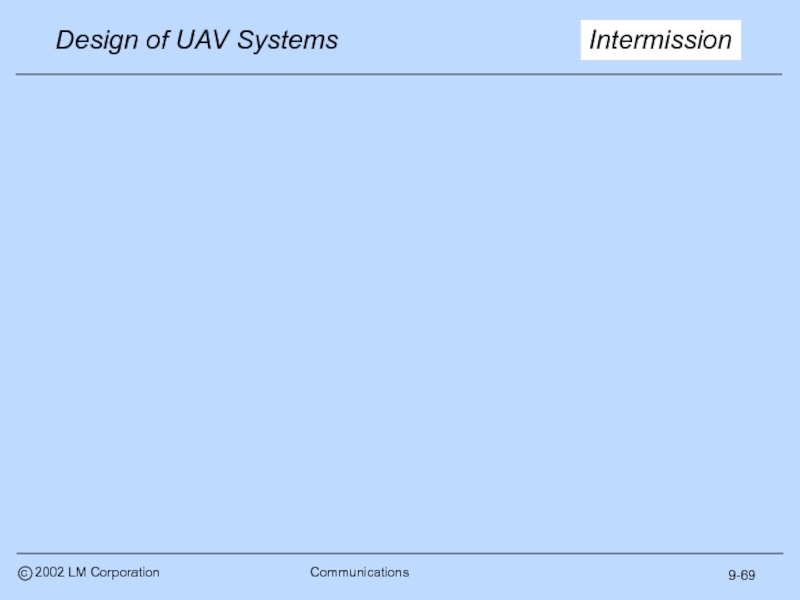Expectations - You will understand the basic issues associated with UAV communications and know how to define (size) a system to meet overall communication requirements
- Главная
- Разное
- Дизайн
- Бизнес и предпринимательство
- Аналитика
- Образование
- Развлечения
- Красота и здоровье
- Финансы
- Государство
- Путешествия
- Спорт
- Недвижимость
- Армия
- Графика
- Культурология
- Еда и кулинария
- Лингвистика
- Английский язык
- Астрономия
- Алгебра
- Биология
- География
- Детские презентации
- Информатика
- История
- Литература
- Маркетинг
- Математика
- Медицина
- Менеджмент
- Музыка
- МХК
- Немецкий язык
- ОБЖ
- Обществознание
- Окружающий мир
- Педагогика
- Русский язык
- Технология
- Физика
- Философия
- Химия
- Шаблоны, картинки для презентаций
- Экология
- Экономика
- Юриспруденция
Design of UAV systems презентация
Содержание
- 1. Design of UAV systems
- 2. 9-1a Schedule revision
- 3. 9-2 Importance Communications are a
- 4. 9-3 RF basics Data link
- 5. 9-4 Data link types Simplex
- 6. 9-5 Frequency bands
- 7. 9-6 UAV frequencies Military and
- 8. 9-7 More basics Carrier frequency
- 9. 9-8 Data rate Many people
- 10. 9-9 Polarity The physical orientation
- 11. 9-10 And more Antenna gain
- 12. 9-11 Examples Inmarsat I (4.8
- 13. 9-12 More basics - losses
- 14. 9-13 Architecture Military
- 15. 9-14 Military vs. civil
- 16. 9-15 Communication types Military operators
- 17. 9-16 Military communications Military communications
- 18. 9-17 UAV architectures UAV communication
- 19. 9-18 US common data links
- 20. 9-19 Global Hawk GDT GDT = Ground “data terminal”
- 21. 9-20 Global Hawk ADT ADT = Air “data terminal”
- 22. 9-21 TCDL ADT & GDT Range goal - 200 Km at 15Kft
- 23. 9-22 Architecture Military Commercial
- 24. 9-23 Control functions
- 25. 9-24 Launch and recovery Located
- 26. 9-25 Enroute Launch and recovery
- 27. 9-26 On station Primary mission
- 28. 9-27 Payload Primary mission control
- 29. 9-28 Down links Down links
- 30. 9-29 Radar “imagery” High resolution
- 31. EO/IR data EO/IR requirements are
- 32. 9-31 System status data Air
- 33. Coverage Local area Line of
- 34. 9-33 Local area communications Close
- 35. Typically require directional data links -
- 36. Relay aircraft - existing line of
- 37. 9-36 Global Hawk SatCom
- 38. Coverage Local area Line of
- 39. 9-38 The time required
- 40. 9-39 Also known as data
- 41. 9-40 The preferred reliability solution
- 42. 9-41 Probability of intercept Probability
- 43. 9-42 More issues Power and
- 44. 9-43 A significant part of
- 45. 9-44 Next subject RF basics
- 46. - Given 2 platforms at distance (D1+D2)
- 47. 9-46 RF line of sight
- 48. 9-47 Grazing angle effects
- 49. 9-48 Airborne relay A system
- 50. 9-49 LOS defines max communication
- 51. 9-50 There is little public
- 52. 9-51 ADT range and power Calculate LOS
- 53. 9-52 Initial sizing - ADT
- 54. 9-53 ADT power required Parametric
- 55. 9-54 ADT weight Parametric data
- 56. 9-55 ADT volume Parametric data
- 57. Parametric correlation basis Known correlation between
- 58. 9-57 ADT satcom antenna Parametric
- 59. 9-58 More ADT LOS data
- 60. 9-59 All systems on an
- 61. 9-60 GDT options There are
- 62. 9-61 GDT parametrics
- 63. 9-62 Expectations You should understand
- 64. 9-63 Final subject RF basics
- 65. 9-64 Example problem Five medium
- 66. 9-65 Parametric data is used
- 67. 9-66 We have little GDT
- 68. 9-67 Requirements update System
- 69. 9-68 Homework Assess communication requirements
- 70. 9-69 Intermission
Слайд 1
9-1
Lesson objective - to discuss
UAV Communications
including …
RF Basics
Communications Issues
Слайд 2
9-1a
Schedule revision
Week 4
Sortie rate estimates
Requirements analysis
Week 5
Communication considerations
Week 6
Control station considerations and sizing
Payload (EO/IR and radar) considerations and sizing
Week 7
Reliability, maintenance, safety and support
Life cycle cost
Week 8
Mid term presentations
Слайд 3
9-2
Importance
Communications are a key element of the overall UAV system
A UAV
- unless it operates totally autonomously
- Only a few (generally older) UAVs operate this way
A good definition (and understanding) of communications requirements is one of the most important products of the UAV concept design phase
Слайд 4
9-3
RF basics
Data link types
Frequency bands
Antennae
Equations
Communications issues
Architecture
Function
Coverage
Etc.
Sizing (air and ground)
Range
Weight
Volume
Power
Example problem
Discussion
Слайд 5
9-4
Data link types
Simplex - One way point-to-point
Half duplex - Two way,
Full duplex - Two way, continuous Tx/Rx
Modem - Device that sends data sent over analog link
Omni directional - Theoretically a transmission in all directions (4π steradian or antenna gain ≡ 0) but generally means 360 degree azimuth coverage
Directional - Transmitted energy focused in one direction (receive antennae usually also directional)
- The more focused the antennae, the higher the gain
Up links - used to control the UAV and sensors
Down links - carry information from the UAV (location, status, etc) and the on-board sensors
Слайд 7
9-6
UAV frequencies
Military and civilian UAVs communicate over a range of frequencies
An informal survey of over 40 UAVs (mostly military, a few civilian) from Janes UAVs and Targets shows:
Up links
Band % using
VHF (RC) 13%
UHF 32%
D 6%
E/F 11%
G/H 21%
J 15%
Ku 2%
Down links
Band % using
VHF 0%
UHF 17%
D 19%
E/F 13%
G/H 23%
J 17%
Ku 9%
Higher frequency down links provide more bandwidth
Слайд 8
9-7
More basics
Carrier frequency
- The center frequency around which a message is
- The actual communication or message is represented by a modulation (e.g. FM) about the carrier
Bandwidth
- The amount (bandwidth) of frequency (nominally centered on a carrier frequency) used to transmit a message
- Not all of it is used to communicate
- Some amount is needed for interference protection
- Sometimes expressed in bauds or bits per second but this is really the data rate
Слайд 9
9-8
Data rate
Many people use band width and data rate as synonymous
Слайд 10
9-9
Polarity
The physical orientation of an RF signal
- Typically determined by the
- But influenced by ground reflection
Two types of polarization, linear and circular
- Linear polarity is further characterized as horizontal (“h-pole”) or vertical (“v-pole”)
- A simple vertical antenna will transmit a vertically polarized signal. The receiving antenna should also be vertical
- V-pole tends to be absorbed by the earth and has poor ground reflection (∴tracking radars are V-pole).
- H-pole has good ground reflection which extends the effective range (∴ used for acquisition radars)
- Circular polarity typically comes from a spiral antenna
- EHF SatCom transmissions are usually circular
- Polarization can be either right or left hand circular
Слайд 11
9-10
And more
Antenna gain - a measure of antenna performance
- Typically defined
- where P/Pi = ability of an antenna to focus power vs. theoretical isotropic (4π steradian) radiation
- Example - an antenna that focuses 1 watt into a 3deg x 3 deg beam (aka “beam width”) has a gain of
10*Log10(1/3^2/1/360^2) = 41.6 dB
- For many reasons (e.g., bit error rates) high gain antennae (>20dBi) are required for high bandwidth data
Example - 10.5 Kbps Inmarsat Arero-H Antenna
- For small size and simplicity, low gain antenna (< 4 dBi) are used………... for low bandwidth data
Example - 600 bps Inmarsat Aero-L Antenna
Слайд 12
9-11
Examples
Inmarsat I (4.8 Kbps) Weight = 18 lb, 6 dB
Data and
Inmarsat H (≈9.6 Kbps) Weight = 102 lb, 12 dB
Inmarsat L (600 bps) Weight = 8 lb, ? dB
Слайд 13
9-12
More basics - losses
Free space loss
- The loss in signal strength
= (λ/4πR)^2
- Example : 10 GHz (λ=0.03m) at 250 Km = 160.4 dBi
Atmospheric absorption
- Diatomic oxygen and water vapor absorb RF emissions
- Example : 0.01 radian path angle at 250 Km = 2.6 dB
Precipitation absorption
- Rain and snow absorb RF emissions
- Example : 80 Km light rain cell at 250 Km = 6.5 dB
Examples from “Data Link Basics: The Link Budget”, L3 Communications Systems West
Слайд 14
9-13
Architecture
Military
Commercial
“Common”
Function
Up link (control)
Launch and recovery
Enroute
On station
Payload control
Down link (data)
Sensor
System status
Communications
Coverage
Local area
Line of sight
Over the horizon
Other issues
Time delay
Survivability
Reliability
Redundancy
Probability of intercept
Logistics
Слайд 15
9-14
Military vs. civil
Military communications systems historically were quite different from
With the exception of fixed base (home country infrastructure) installations, military communications systems are designed for operations in remote locations under extreme environmental conditions
They are designed for transportability and modularity
- Most are palletized and come with environmental shelters
Civilian communications systems were (and generally still are) designed for operation from fixed bases
Users are expected to provide an environmentally controlled building (temperature and humidity)
Now, however, the situation has changed
Слайд 16
9-15
Communication types
Military operators now depend on a mix of civilian and
- Cell phones and SatCom have joined the military
Global Hawk example
Слайд 17
9-16
Military communications
Military communications systems generally fall into one of two categories
Integrated
the communications infrastructure
Dedicated - unique to a system
Dedicated
Слайд 18
9-17
UAV architectures
UAV communication systems are generally dedicated
The systems may have other
US military UAVs have an objective of common data link systems across all military UAVs (e.g.TCDL)
Multiple UAV types could be controlled
Frequencies or geographic areas are allocated to specific UAVs to prevent interference or “fratricide”
UAV communications equipment is generally integrated with the control station
This is particularly true for small UAVs and control stations
Larger UAVs can have separate communications pallets
Слайд 19
9-18
US common data links
Excerpts from - Survey of Current Air Force
A program which defines a set of common and interoperable waveform characteristics
A full duplex, jam resistant, point-to-point digital, wireless RF communication architecture
Used with intelligence, surveillance and reconnaissance (ISR) collection systems
Classes & tech base examples
Class IV (SatCom) - DCGS (Distributed Common Ground System)
Class III (Multiple Access) - RIDEX (AFRL proposed)
Class II (Protected) - ABIT (Airborne Information transfer)
Class I (High Rate) - MIST (Meteorological info. std. terminal)
Class I (Low Rate) - TCDL (Tactical CDL)
Слайд 23
9-22
Architecture
Military
Commercial
“Common”
Function
Up link (control)
Launch and recovery
Enroute
On station
Payload control
Down link (data)
Sensor
System status
Next subject
Coverage
Local area
Line of sight
Over the horizon
Other issues
Time delay
Survivability
Reliability
Redundancy
Probability of intercept
Logistics
Слайд 25
9-24
Launch and recovery
Located at the operating base
Control the UAV from
Communications must be tied in with other base operations
- Usually 2-way UHF/VHF (voice) and land line
Also linked to Mission Control (may be 100s of miles away)
Global Hawk Launch Recovery Element
Слайд 26
9-25
Enroute
Launch and recovery or mission control responsibility
Control the UAV through
- Usually 2-way UHF/VHF (voice)
Primary responsibility is separation from other traffic - particularly manned aircraft (military and civil)
- UAV control by line of sight, relay and/or SatCom data link
Global Hawk Mission Control Element
Слайд 27
9-26
On station
Primary mission control responsibility
Control the UAV air vehicle in
- Bandwidth requirements typically 10s-100s Kpbs
Control sometimes handed off to other users
- Mission control monitors the operation
http://www.fas.org/irp/program/collect/predator.htm
http://www.fas.org/irp/program/collect/predator.htm
Слайд 28
9-27
Payload
Primary mission control responsibility
Control the sensors in the target area
- Sensor control modes include search and spot
- High bandwidth required (sensor control feedback)
Sensor control sometimes handed off to other users
EO/IR sensor control
SAR radar control
Слайд 29
9-28
Down links
Down links carry the most valuable product of a UAV
UAV sensor and position information that is transmitted back for analysis and dissemination
- Exception, autonomous UAV with on board storage
Or UCAV targeting information that is transmitted back for operator confirmation
Real time search mode requirements typically define down link performance required
Non-real time “Images” can be sent back over time and reduce bandwidth requirements
Line of sight down link requirements cover a range from a few Kbps to 100s of Mbps, SatCom down link requirements are substantially lower
Слайд 30
9-29
Radar “imagery”
High resolution “imagery” (whether real or synthetic) establishes the down
Example - Global Hawk has 138,000 sqkm/day area search area at 1m resolution. Assuming 8 bits per pixel and 4:1 compression, the required data rate would be 3.2 Mbps to meet the SAR search requirements alone*
- In addition to this, the data link has to support 1900, 0.3 m resolution 2 Km x 2 Km SAP spot images per day, an equivalent data rate of 2.0 Mbps
- Finally there is a ground moving target indicator (GMTI) search rate of 15,000 sq. Km/min at 10 m resolution, an implied data rate of about 5Mbps
Total SAR data rate requirement is about 10 Mbps
*See the payload lesson for how these requirements are calculated
Слайд 31
EO/IR data
EO/IR requirements are for comparable areas and resolution. After compression,
This is why Global Hawk has a high bandwidth data link
* Flight International, 30 January 2002
9-30
Слайд 32
9-31
System status data
Air vehicle system status requirements are small in comparison
- Fuel and electrical data can be reported with a few bits of data at relatively low rates (as long as nothing goes wrong - then higher rates required)
- Position, speed and attitude data files are also small, albeit higher rate
- Subsystem (propulsion, electrical, flight control, etc) and and avionics status reporting is probably the stressing requirement, particularly in emergencies
Although important, system status bandwidth requirements will not be design drivers
- A few Kbps should suffice
Once again, the sensors, not system status, will drive the overall data link requirement
Слайд 33Coverage
Local area
Line of sight
Over the horizon
Other issues
Time delay
Survivability
Reliability
Redundancy
Probability of intercept
Logistics
9-32
Next
Architecture
Military
Commercial
“Common”
Function
Up link (control)
Launch and recovery
Enroute
On station
Payload control
Down link (data)
Sensor
System status
Слайд 34
9-33
Local area communications
Close range operations (e.g., launch and recovery) typically use
- All azimuth, line of sight
- Air vehicle and ground station impact minimal
Communications must be tied in with other base operations
- Usually 2-way UHF/VHF (voice) and land line
Omni-directional antennae
Слайд 35Typically require directional data links
- RF focused on control station
- Impact on small air vehicles significant
- Impact on larger air vehicles less significant
- Significant control station impact
Communications requirements include air traffic control
- Usually 2-way UHF/VHF (voice)
9-34
Long range comms (LOS)
Hunter
http://www.fas.org/irp/program/collect/pioneer.htm
Слайд 36
Relay aircraft - existing line of sight equipment
Minimal air vehicle design
Major operational impact
9-35
Over the horizon options
Low bandwidth - minimal design impact, major operational
High bandwidth - major impact (design and operational)
SatCom
Слайд 38Coverage
Local area
Line of sight
Over the horizon
Other issues
Time delay
Survivability
Reliability
Redundancy
Probability of intercept
Logistics
9-37
Architecture
Military
Commercial
UAV
Function
Up
Launch and recovery
Enroute
On station
Payload control
Down link (data)
Sensor
System status
Слайд 39
9-38
The time required to transmit, execute and feed back a
- A SatCom problem
Example:
- 200 Km LOS @ c = 3x10^5 Km/sec
- Two way transmission time = 1.33 msec
- Geo stationary Satcom at 35,900 Km
- Two way transmission time = 240 msec
Other issues - time delay
Raw data from, Automated Information Systems Design Guidance - Commercial Satellite Transmission, U.S. Army Information Systems Engineering Command
(http://www.fas.org/spp/military/docops/army/index.html)
Inmarsat M
(500 msec?)
Слайд 40
9-39
Also known as data “latency” or “lag”
- Limited by speed of
All systems have latency
- Human eye flicker detection - 30 Hz (33 msec delay)
- Computer screen refresh rate - 75 Hz (13 msec)
- Computer keyboard buffer latency - 10 to 20 msec
- LOS communications - 2 msec
- LEO SatCom - 10 msec
- MEO Satcom - 100 msec
- GEO Satcom - 200 to 300 msec
- Typical human reaction - 150-250 msec
Acceptable overall system lag varies by task
< 40 msec for PIO susceptible flight tasks (low L/D)
< 100 msec for “up and away” flight tasks (high L/D)
When OTH control latency > 40 msec, direct control of a UAV is high risk (except through an autopilot)
Time delays and UAVs
Слайд 41
9-40
The preferred reliability solution
Separate back up data link(s)
Most modern UAVs have
Global Hawk has 4 (two per function)
- UHF (LOS command and control)
- UHF (SatCom command and control)
- CDL (J-band LOS down link)
- SHF (SatCom Ku band down link)
Dark Star also had four (4)
Predator, Shadow 200 have two (2)
Most UAVs also have pre-programmed lost link procedures
- If contact lost for TBD time period (or other criteria) return to pre-determined point (near recovery base)
- Loiter until contact re-established (or fuel reaches minimum levels then initiate self destruct)
Other issues - redundancy
Слайд 42
9-41
Probability of intercept
Probability that an adversary will be able to detect
1. Establish track on the UAV position
2. Interfere with (or spoof) commands
Purely a military UAV issue
No known civil equivalent
Some well known techniques
- Spread spectrum
- Random frequency hopping
- Burst transmissions
- Difficult to detect and track
- Power management
- No more power than required to receive
- Narrow beam widths
- Difficult intercept geometry
Слайд 43
9-42
More issues
Power and cooling
Communications equipment (especially transmitters) require significant power and
- At low altitudes, meeting these power and cooling requirements typically is not an issue
- At high altitude, both are a problem since power and cooling required ≈ constant and ….
- Power available approximately proportional δ
- Cooling air required(cfm) approximately proportional 1/σ; one reason why high-altitude aircraft use fuel for cooling (also keeps the fuel from freezing!)
Слайд 44
9-43
A significant part of transport requirements are associated with communications equipment
C-141B
Other issues - logistics
Слайд 45
9-44
Next subject
RF basics
Data link types
Frequency bands
Antennae
Equations
Communications issues
Architecture
Function
Coverage
Etc.
Sizing (air and ground)
Range
Weight
Volume
Power
Example
Слайд 46- Given 2 platforms at distance (D1+D2) apart at altitudes h1
D1+D2 ≡ Re*{ArcCos[(Re+hmin)/(Re+h2)]+
ArcCos[(Re+hmin)/(Re+h1)]} (9.1)
Re ≈ 6378 km (3444 nm)
hmin = intermediate terrain or weather avoidance altitude (≈ 20kft)*
ArcCos[ ] is measured in radians
*not applicable if h1 and/or h2 lower than hmin
- From geometry
where
and
9-45
Line of sight (LOS) calculations
Слайд 47
9-46
RF line of sight
Due to earth curvature and atmospheric index of
Another equation for communication LOS can be found using a simple radar horizon equation from Skolnik (page 24-8) where:
- LOS(statute miles) ≈ √2*h(ft) (9.2)
or
- LOS(nm) ≈ 0.869√2*h(ft) (9.3)
Note that the ratio of Eqs 9.1 and 9.3 for h1 = hmin = 0 and h2 = h is √4/3 ; e.g. LOS (Eq 9.1) = 184 nm @ h2 = 30Kft while LOS (Eq 9.3) = 213 nm
- We will assume that the √4/3 factor will correct any geometric LOS calculation including 9.4 when h1 and h2min ≠ 0
Слайд 48
9-47
Grazing angle effects
Ignore the small differences between LOS and LOS’
Given a platform at altitude h at grazing angle θ above the horizon:
Re
h
Local horizon
θ
LOS’
LOS
Слайд 49
9-48
Airborne relay
A system level solution for an organic over the horizon
Requires that relay UAV(s) stay airborne at all times
- For extended range and/or redundancy
Also requires separate communication relay payload
- In addition to basic UAV communication payload
But relay platform location is critical. Example:
Four (4) WAS UAVs loiter at 27 Kft and one (1) ID UAV loiter at 10 Kft over a 200 nm x 200 nm combat area located 100 nm from base
Two (2) WAS UAVs closest to base function as communications relays for the three other UAVs
Typical terrain altitude over the area is 5 Kft
How would a WAS relay have to operate to provide LOS communications to the ID UAV at max range?
Слайд 50
9-49
LOS defines max communication distance for relay
- At θ =0.75°,
At hmin = 5 kft, LOS from ID UAV at 10 Kft to WAS relay at 27 Kft = 269.2 nm vs. 212 nm req’d
WAS altitude inadequate to meet base relay requirement
Relay example
100 nm
200 nm x 200 nm
158 nm
10 Kft
27 Kft
156.7 nm
269.2 nm
212 nm
Altitude increase to 27.4 Kft required
Слайд 51
9-50
There is little public information available on UAV data links to
- Including both air and ground data “terminals”
Short hand notation - ADT and GDT
Three sources
1. Janes UAVs and Targets, Issue 14, June 2000
- Mostly military UAV data links
2. Unpublished notebook data on aircraft communications equipment
- Both military and civil, not UAV unique
3. Wireless LAN data
- Collected from the internet, not aircraft qualified
- Indicative of what could be done with advanced COTS technology
For actual projects, use manufacturer supplied data
Next - sizing data
Слайд 529-51
ADT range and power
Calculate LOS range
Equations 9.1-9.4
Estimate RF output power required
Слайд 53
9-52
Initial sizing - ADT Satcom
Parametric correlation basis
Known correlation between band width
- Bandwidth availability increases with frequency
Parametric data source
All Satcom data links
Frequency range 0.24 - 15 GHz
Bandwidth range 0.6 Kbps - 5.0 Mbs
Select Bandwidth
Select frequency
Слайд 54
9-53
ADT power required
Parametric data source
Military line of sight data links
Frequency
Bandwidth range 0.01-5.0 Mbs
Estimate input power requirements
- LOS
- SatCom (GEO)
Слайд 55
9-54
ADT weight
Parametric data source
Janes and unpublished data
Frequency range 30 MHz
Bandwidth range 0.01-5.0 Mbs
Estimate weight
- LOS
- SatCom (GEO)
Note - excludes antennae
Слайд 56
9-55
ADT volume
Parametric data source
All LOS data links & modems
Frequency range
Bandwidth range 0.01-5.0 Mbs
Estimate volume
- LOS
- SatCom (GEO)
Слайд 57Parametric correlation basis
Known correlation between bandwidth required and size
Antenna characteristic
- For EHF : square root of antenna area (when known) or cube root of installed volume
- For UHF : antenna length (blade) or diameter (patch)
9-56
ADT Satcom antenna
Parametric data source
All Satcom data link antenna
Frequency range 0.24 - 15 GHz
Bandwidth range 0.6 Kbps - 5.0 Mbs
Estimate antenna “size”
Calculate area, volume or length as appropriate
Слайд 58
9-57
ADT satcom antenna
Parametric data source
All Satcom data link antenna
Frequency range
Bandwidth range 0.6 Kbps - 5.0 Mbs
Estimate antenna weight
Слайд 59
9-58
More ADT LOS data
Median = .025
Median = .045
Parametric data
All LOS data links & modems
Frequency range 30 MHz - 15 GHz
Bandwidth range 0.01-5.0 Mbs
Слайд 60
9-59
All systems on an air vehicle have an installation weight and
We will assume a typical installation at 130% of dry uninstalled weight
We will make this assumption for all installed items (mechanical systems, avionics, engines, etc.)
Installed volume is estimated by allowing space around periphery, assume 10% on each dimension
Installed volume = 1.33 uninstalled volume
For frequently removed items or those requiring air cooling, we will add 25% to each dimension
Installed volume = 1.95 uninstalled volume
Payloads and data links should be installed this way
Installation considerations
Слайд 61
9-60
GDT options
There are a few GDT system descriptions in Janes and
- Little technical data is provided but in general they are large
- The CL-289 GDT is integrated into a truck mounted ground control station and includes a 12 meter hydraulic antenna mast
- The Elta EL/K-1861 has G and I-band dish antennae (6 ft and 7ft diameter, respectively)
- The AAI GDT appears to be about a 2 meter cube excluding the 1.83 m C-band antenna
- Smaller man portable systems are also described but little technical performance data is included
The following parametrics are very approximate and should be used only until you get better information from manufacturers
Слайд 63
9-62
Expectations
You should understand
Communications fundamentals
UAV unique communications issues
How to calculate communication
How to define (size) a system to meet overall communication requirements
Слайд 64
9-63
Final subject
RF basics
Data link types
Frequency bands
Antennae
Equations
Communications issues
Architecture
Function
Coverage
Etc.
Sizing (air and ground)
Range
Weight
Volume
Power
Example
Слайд 65
9-64
Example problem
Five medium UAVs, four provide wide area search, a fifth
WAS range required (95km) not a challenge
Only one UAV responds to target ID requests
No need to switch roles, simplifies ConOps
No need for frequent climbs and descents
Communications distances reasonable (158nm & 212 nm)
Speed requirement = 280 kts
Air vehicle operating altitude
differences reasonable
We will study other options as trades
What is a reasonable communications architecture?
How big are the parts?
Altitude increase required to meet LOS relay requirement
Слайд 66
9-65
Parametric data is used to size (1) a basic UAV data
We assume both are identical and that all UAVs carry both, allowing any UAV to function as a relay
Provides communication system redundancy
Parametric sizing as follows (for each system)
Max range = 212 nm ⇒ RF power = 110 W (Chart 51)
⇒ Power consumption = 500 W (Chart 53)
⇒ Weight = 27 lbm (Chart 54)
⇒ Volume = 500 cuin (Chart 55)
We have no non-Satcom antenna parametric data and simply assume a 12 inch diameter dish, weighing 25 lbm with volume required = 2 cuft
If you have no data, make an educated guess, document it and move on
We will always check the effect later
We include communications in our payload definition
ADT sizing
Слайд 67
9-66
We have little GDT parametric sizing date and simply assume an
250 lbm and 9.5 cuft
Antenna size will be a function of frequency and bandwidth which we will select after assessing our payload down link requirements
GDT sizing
Слайд 68
9-67
Requirements update
System element
GDT weight/volume/power excluding antenna (each)
= 205 lbm/9.5
GDT installations required = 2
Payload element
Installed weight/volume/power = TBD
WAS
Range/FOR /resolution/speed = 95 km/±45°/10m/2mps
Uninstalled weight/volume/power = TBD
ID
Type/range/resolution = TBD/TBD/0.5m
Uninstalled weight/volume/power = TBD
Communications
Range/type = 212nm/air vehicle and payload C2I
Uninstalled weight/volume/power ≤ 52 lbm/2.3 cuft/500 W
Range/type = 158nm/communication relay
Uninstalled weight/volume/power ≤ 52 lbm/2.3 cuft/500 W
Air vehicle element
Cruise/loiter altitudes = 10 – 27.4Kft
Слайд 69
9-68
Homework
Assess communication requirements for your project and develop an architecture that
(1) Define a communications architecture that includes redundancy considerations
(2) Calculate LOS distances from base to vehicle(s) at the required operating altitudes.
- Assume minimum grazing angle (θ) = 0.75°
(3) If your architecture includes airborne relay, calculate the relay distances at your operating altitudes
- Use the example problem as a guide
(4) Determine the ADT weight, volume and power req’d
(5) Document your derived requirements
Submit your homework via Email to Egbert by COB next Thursday. Document all calculations
